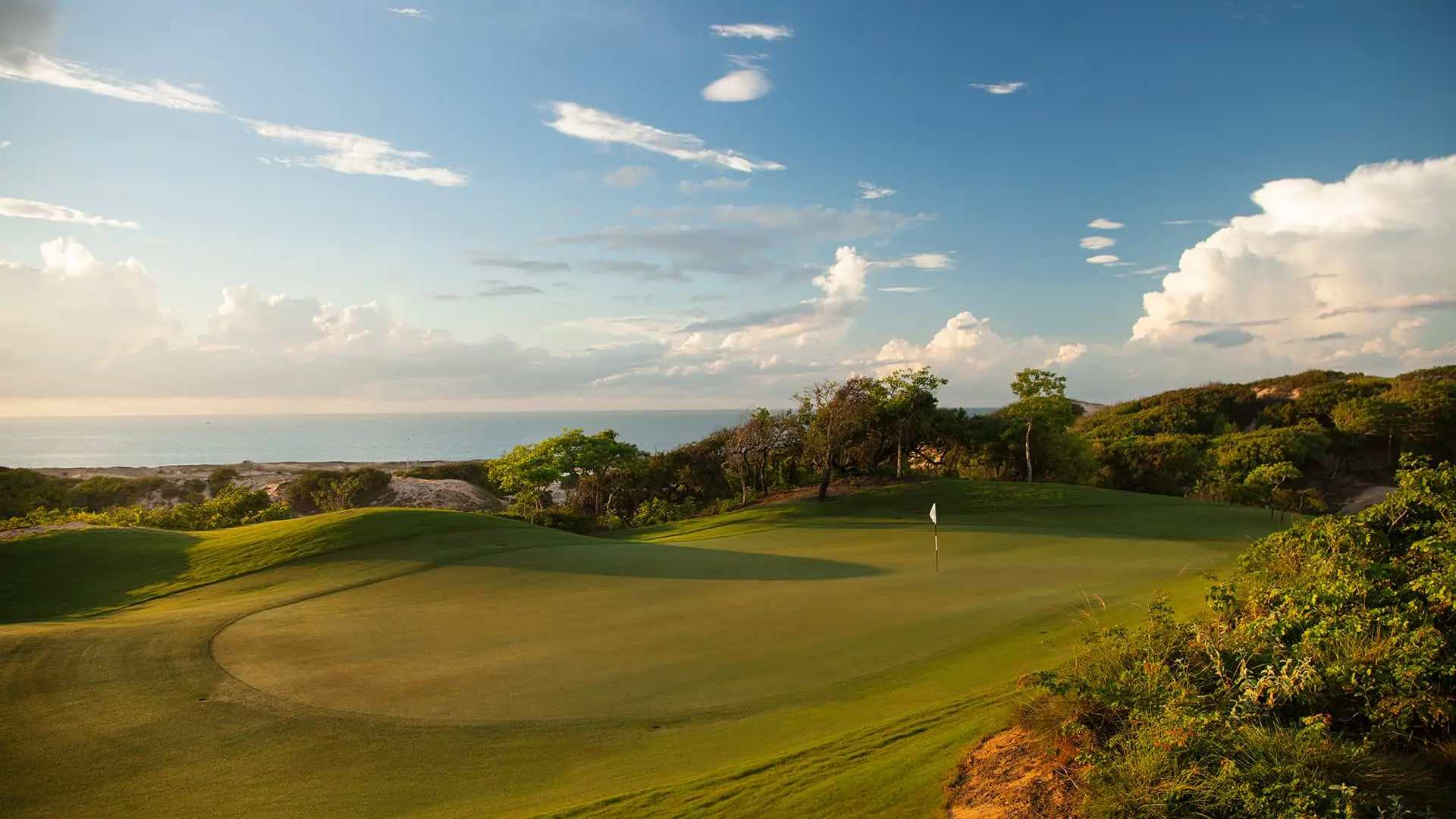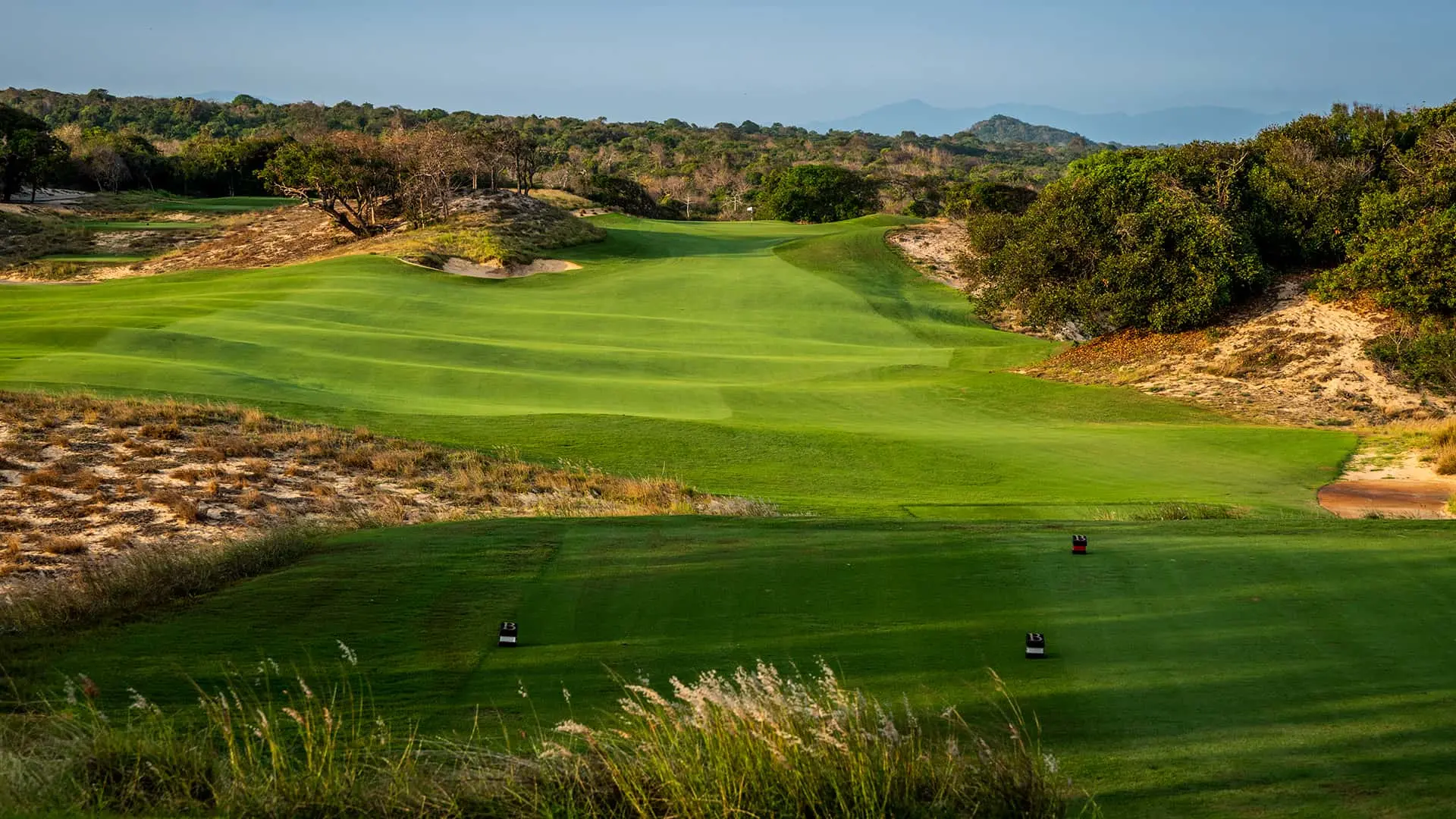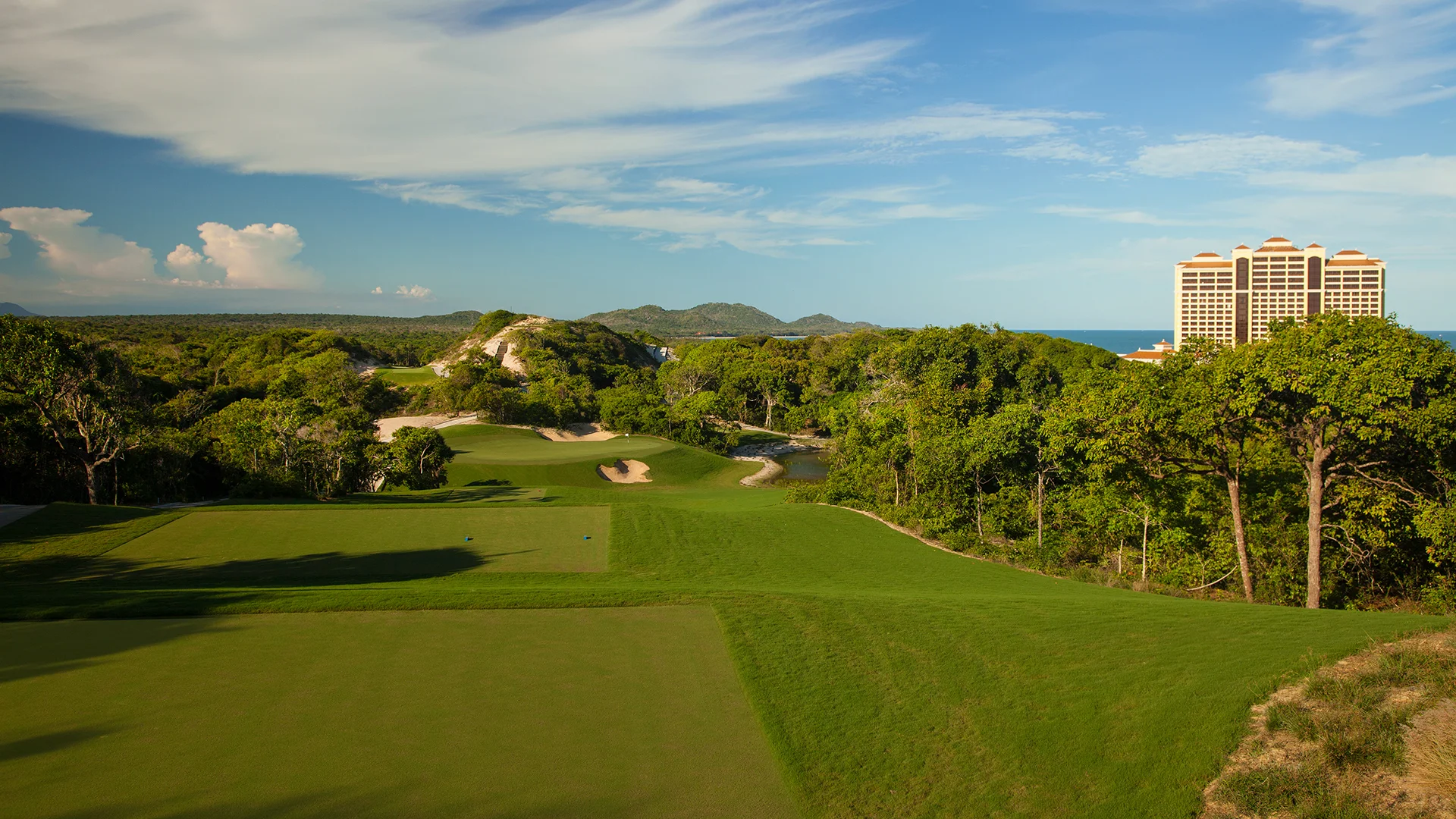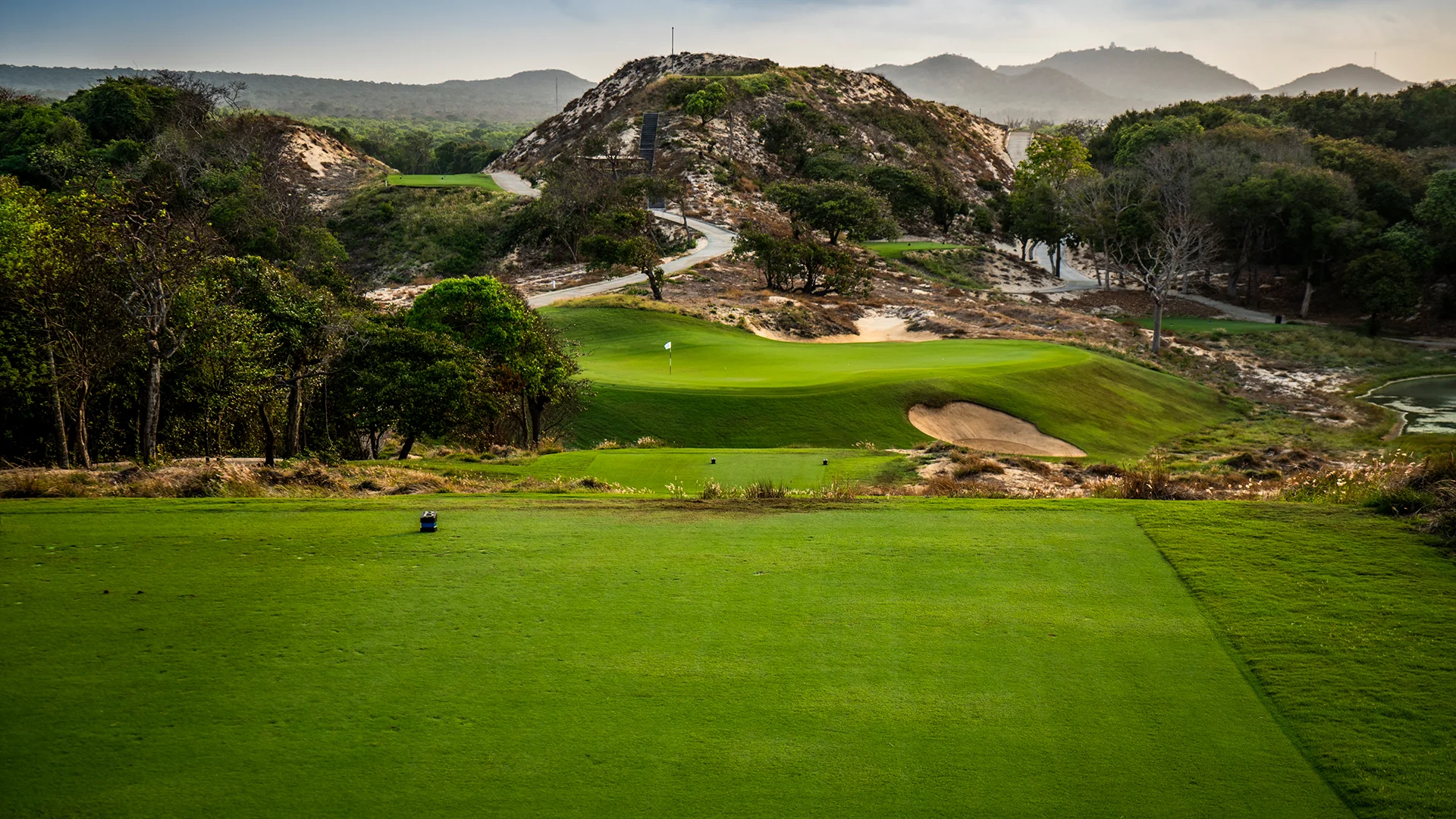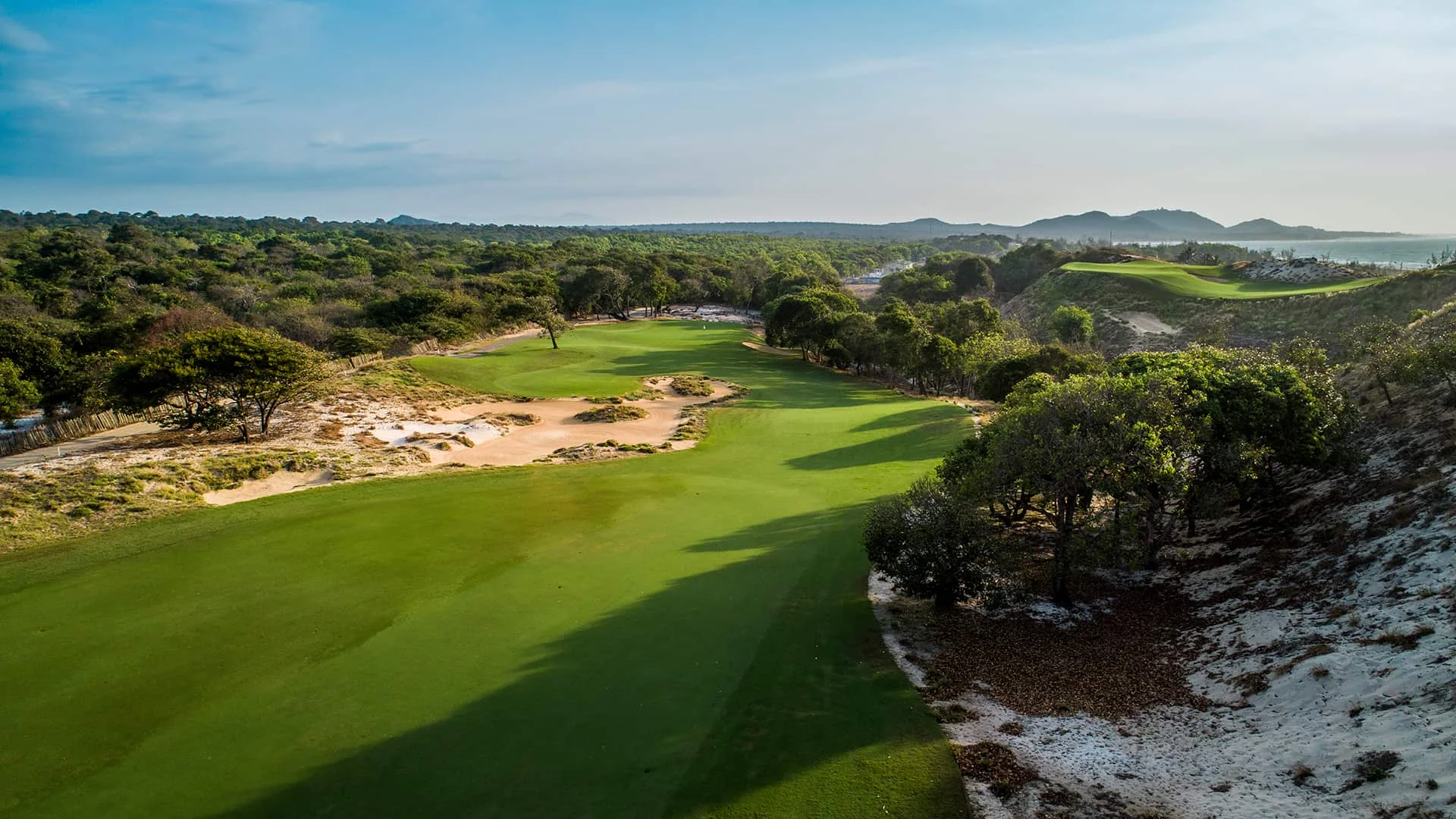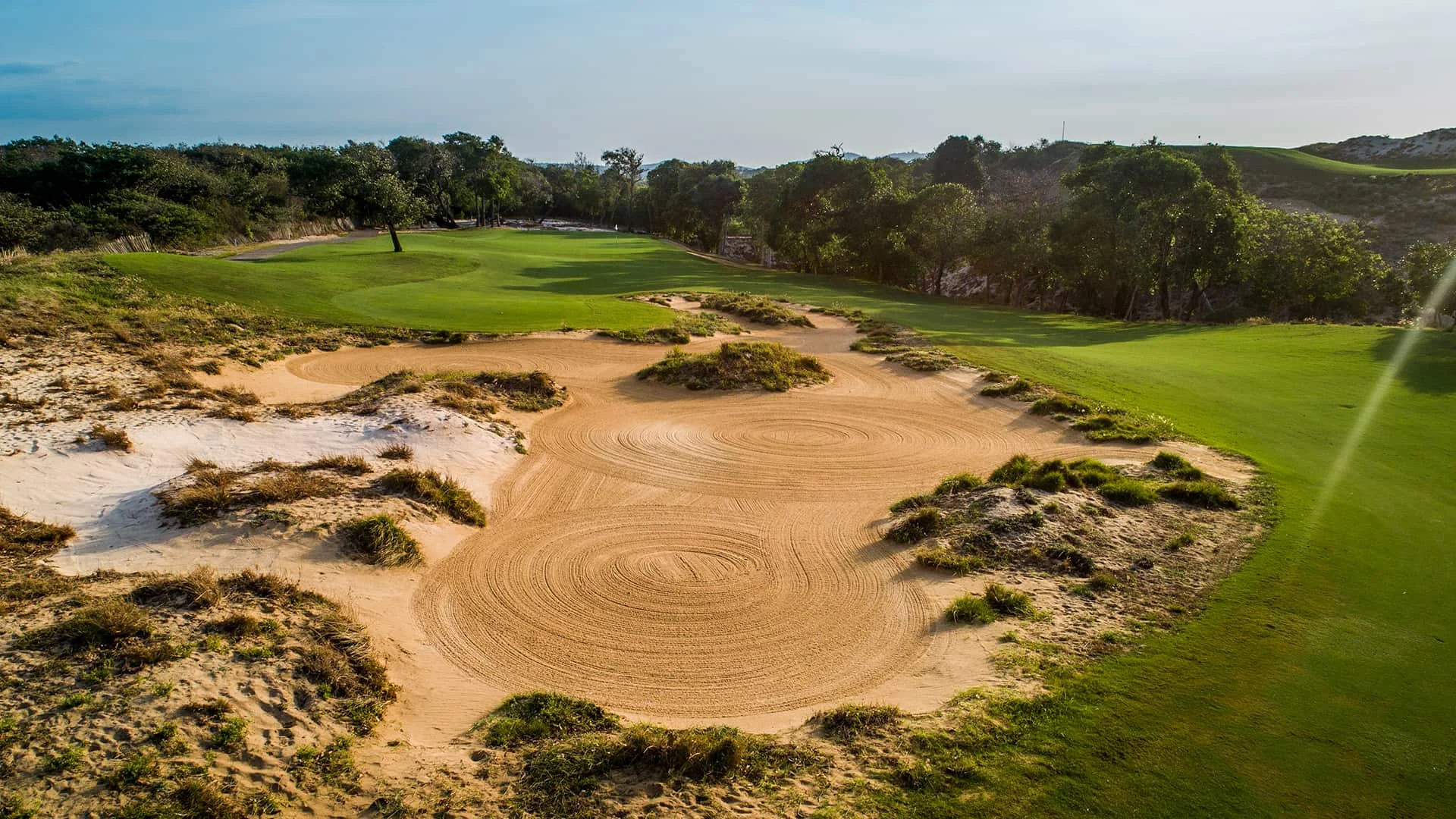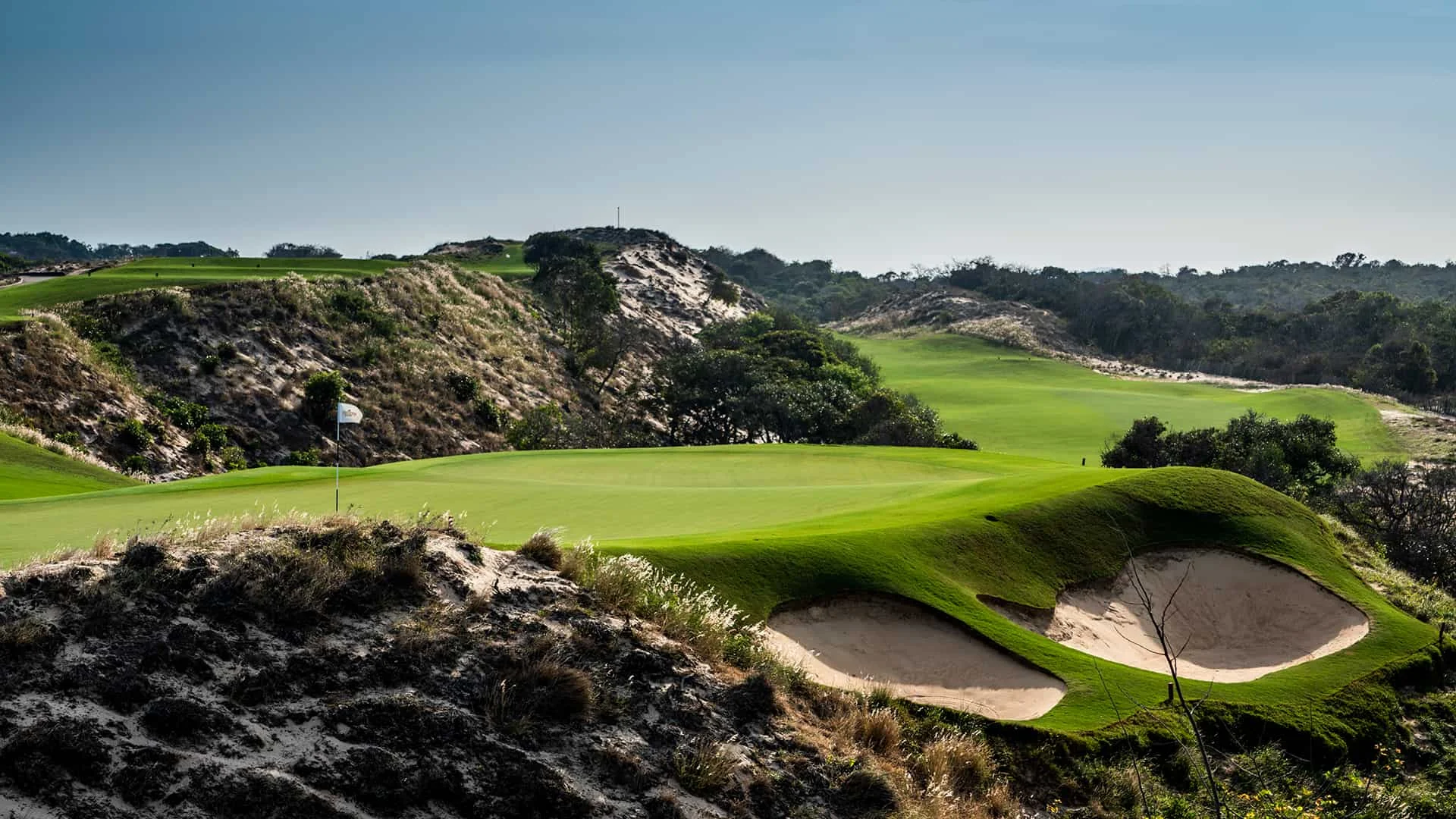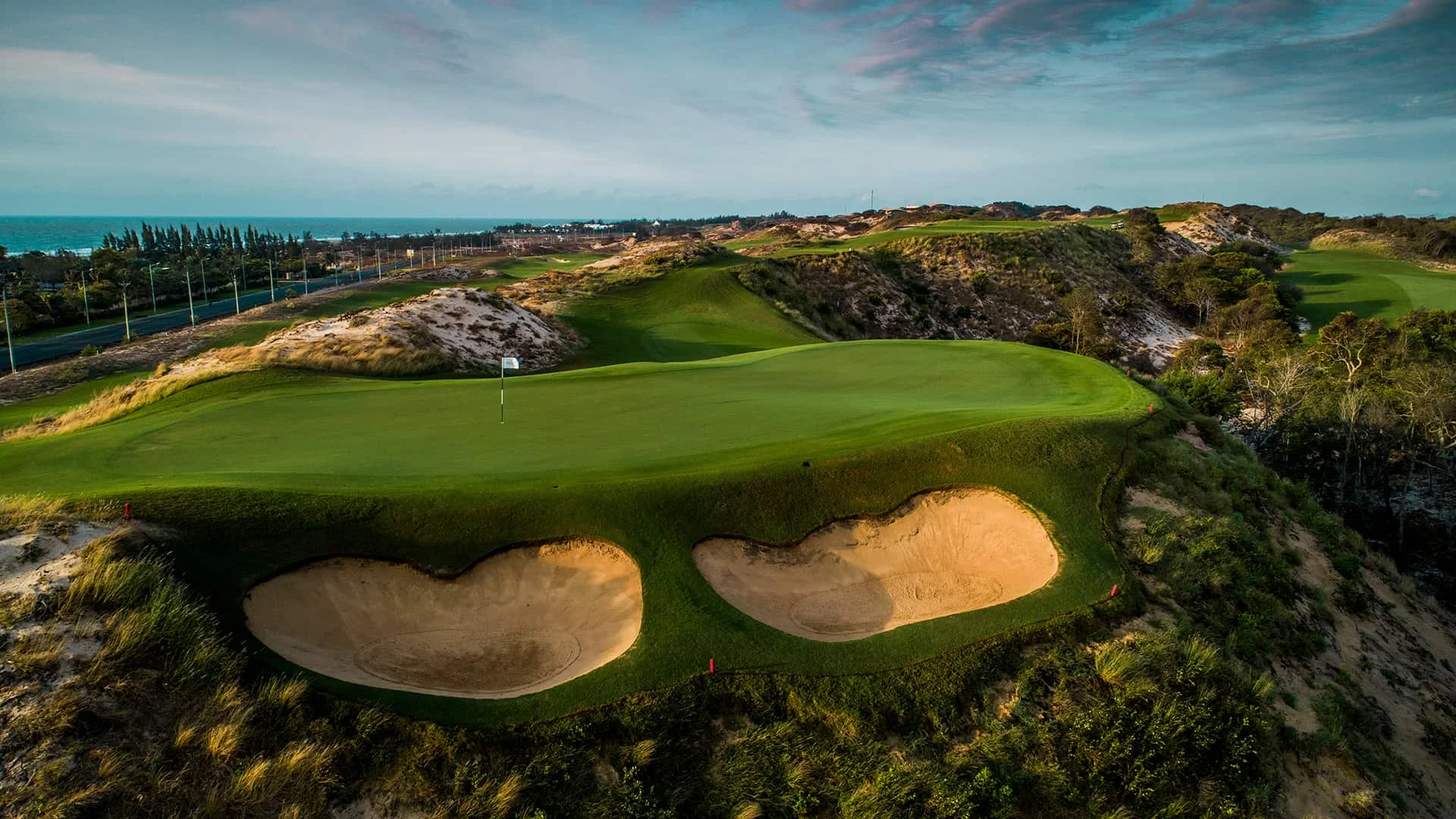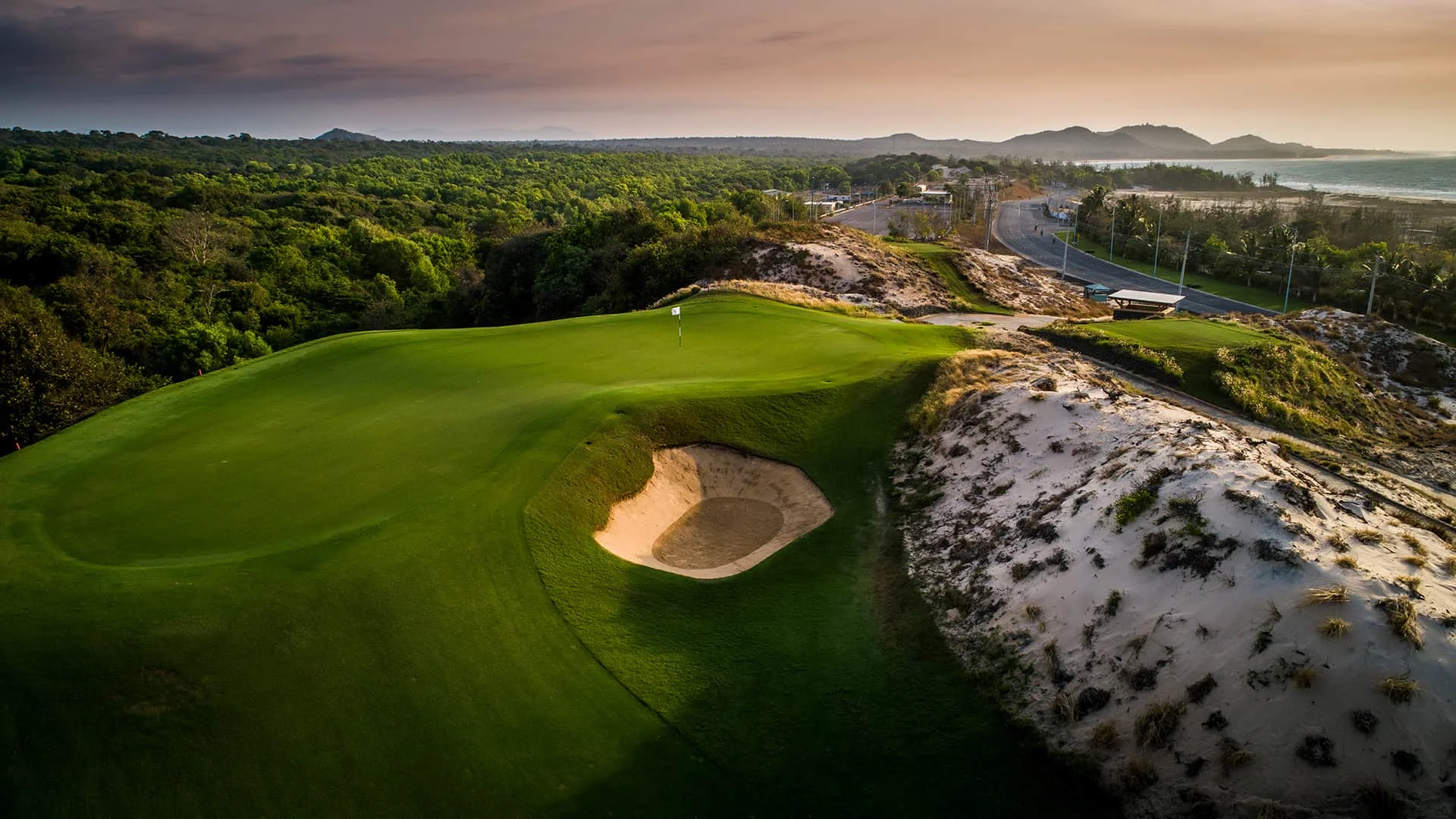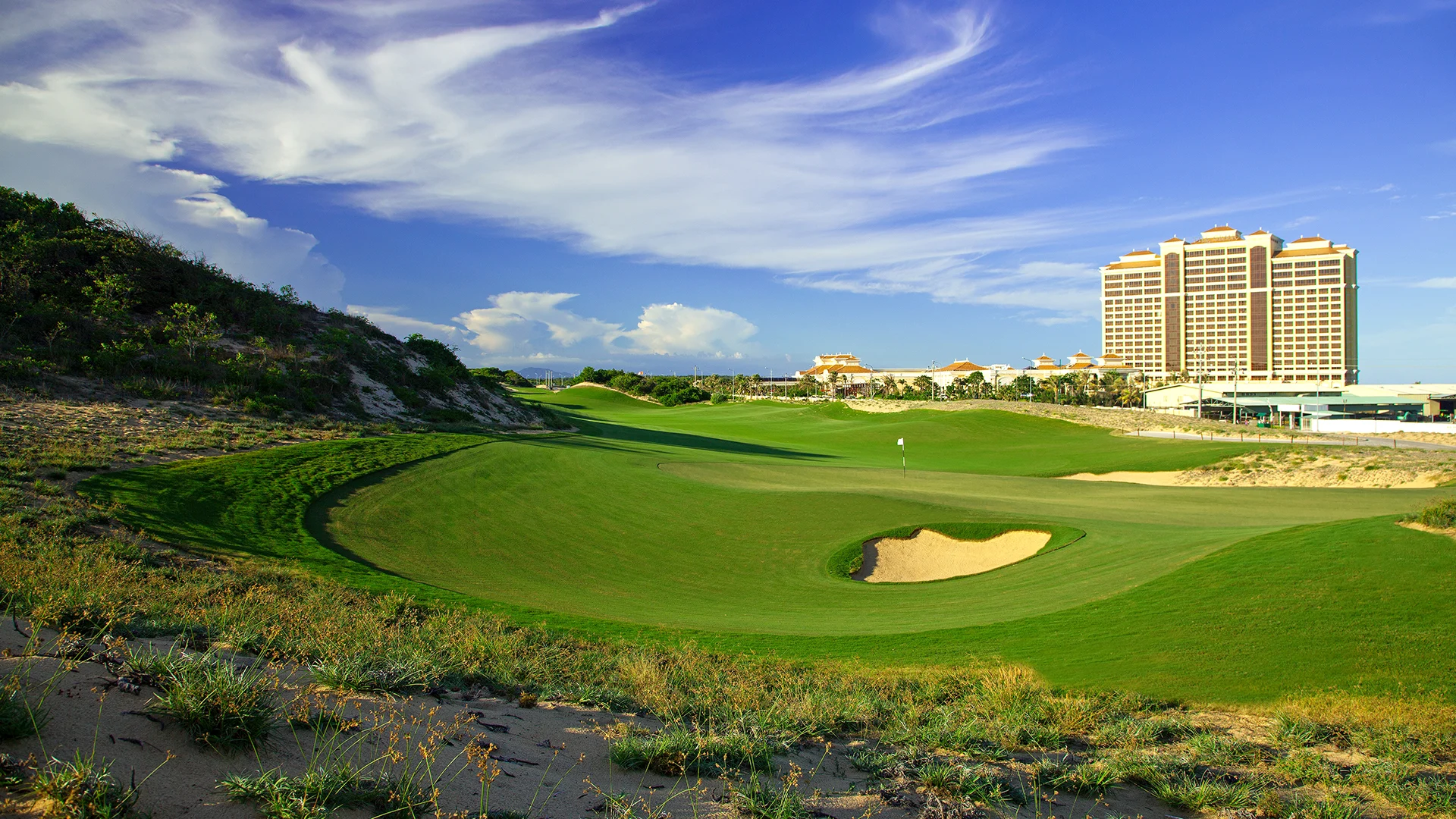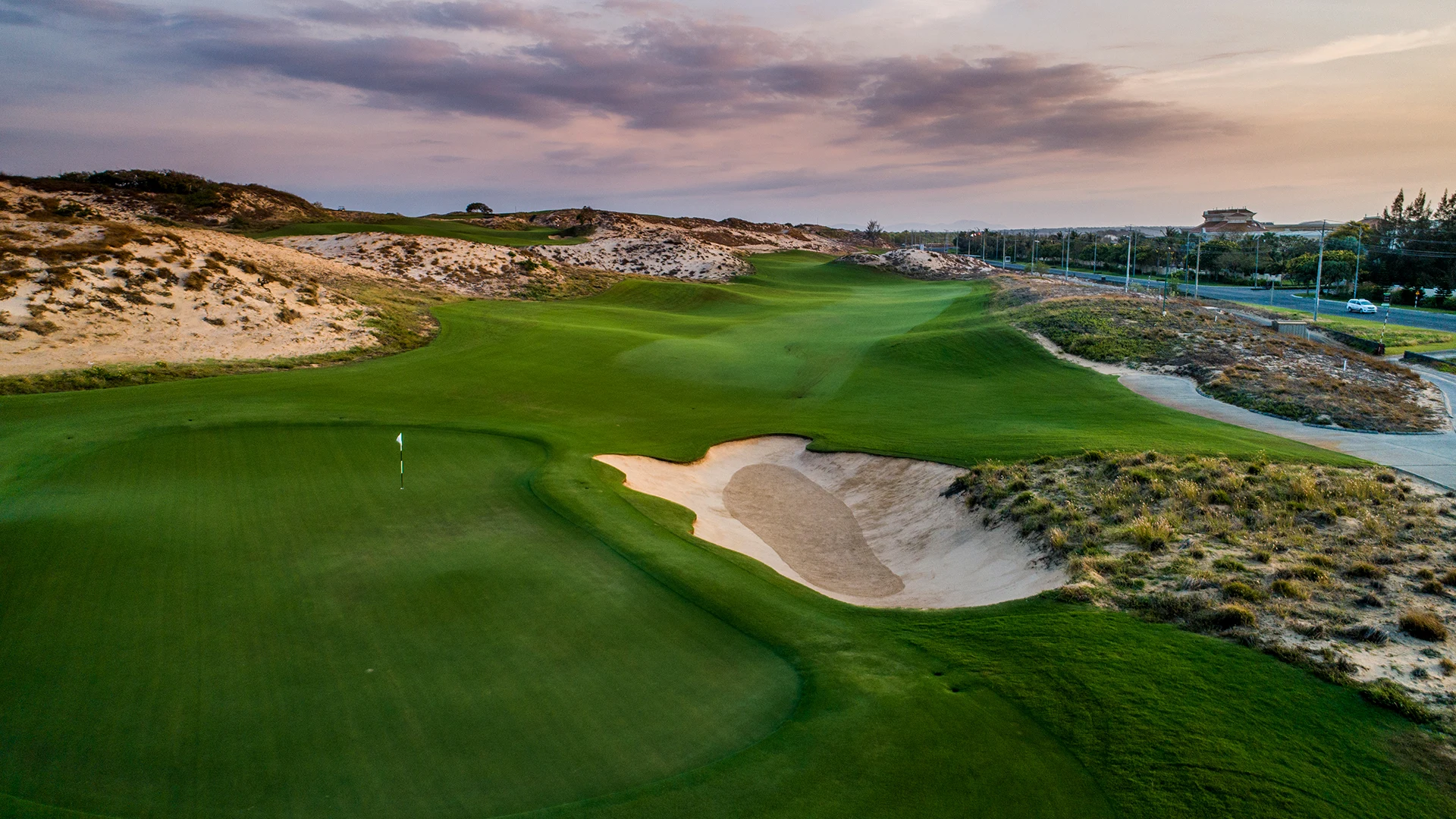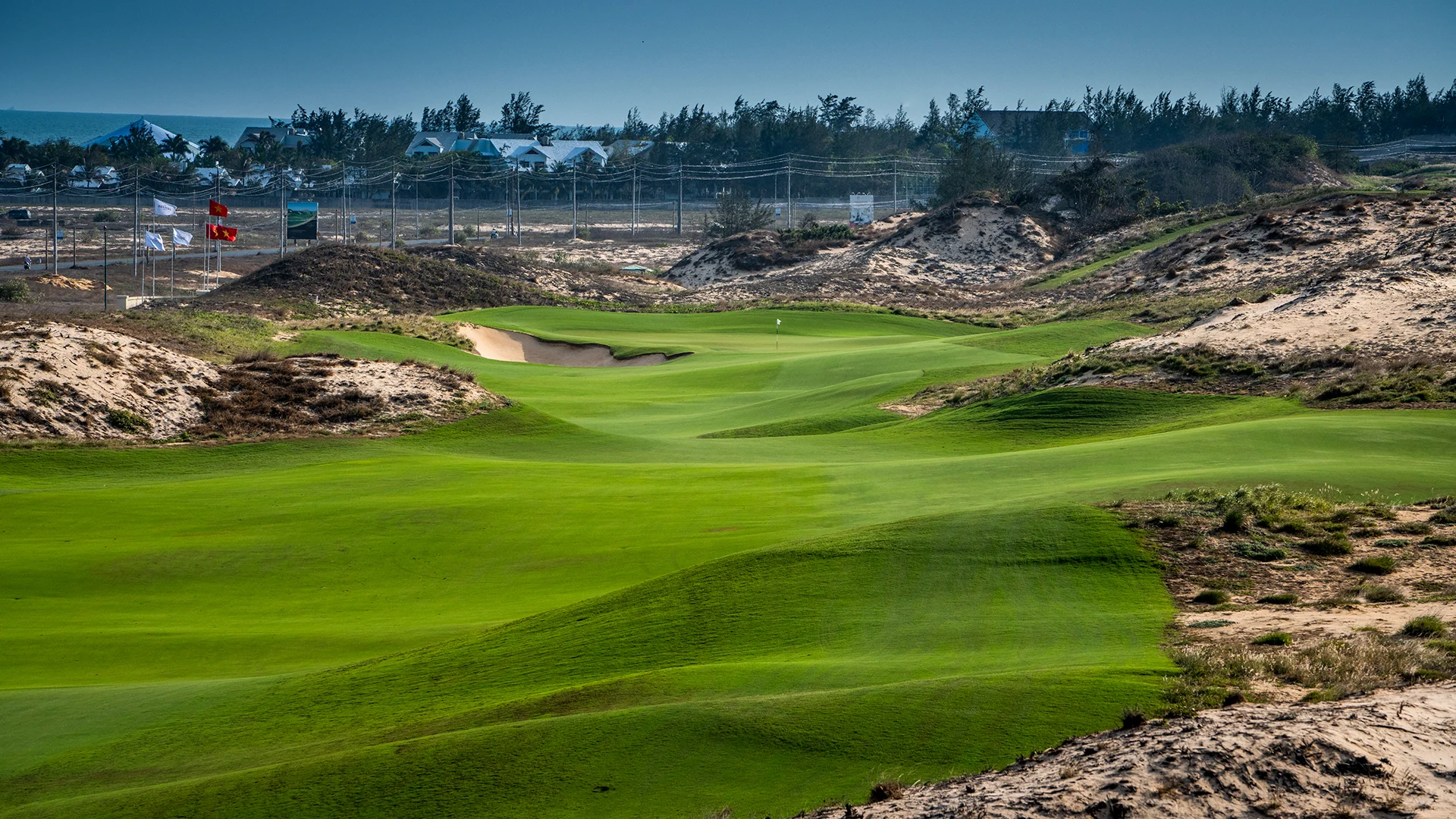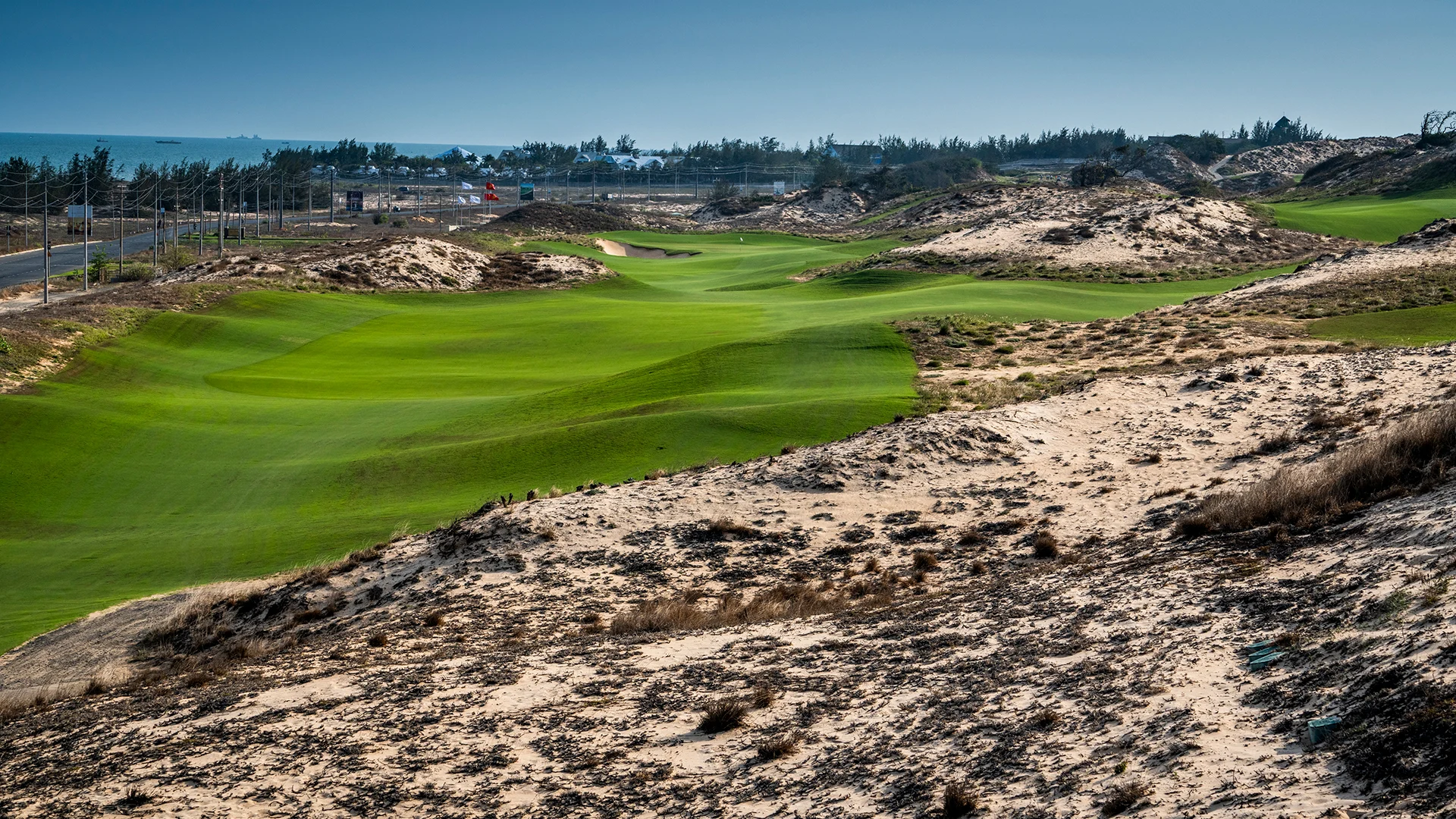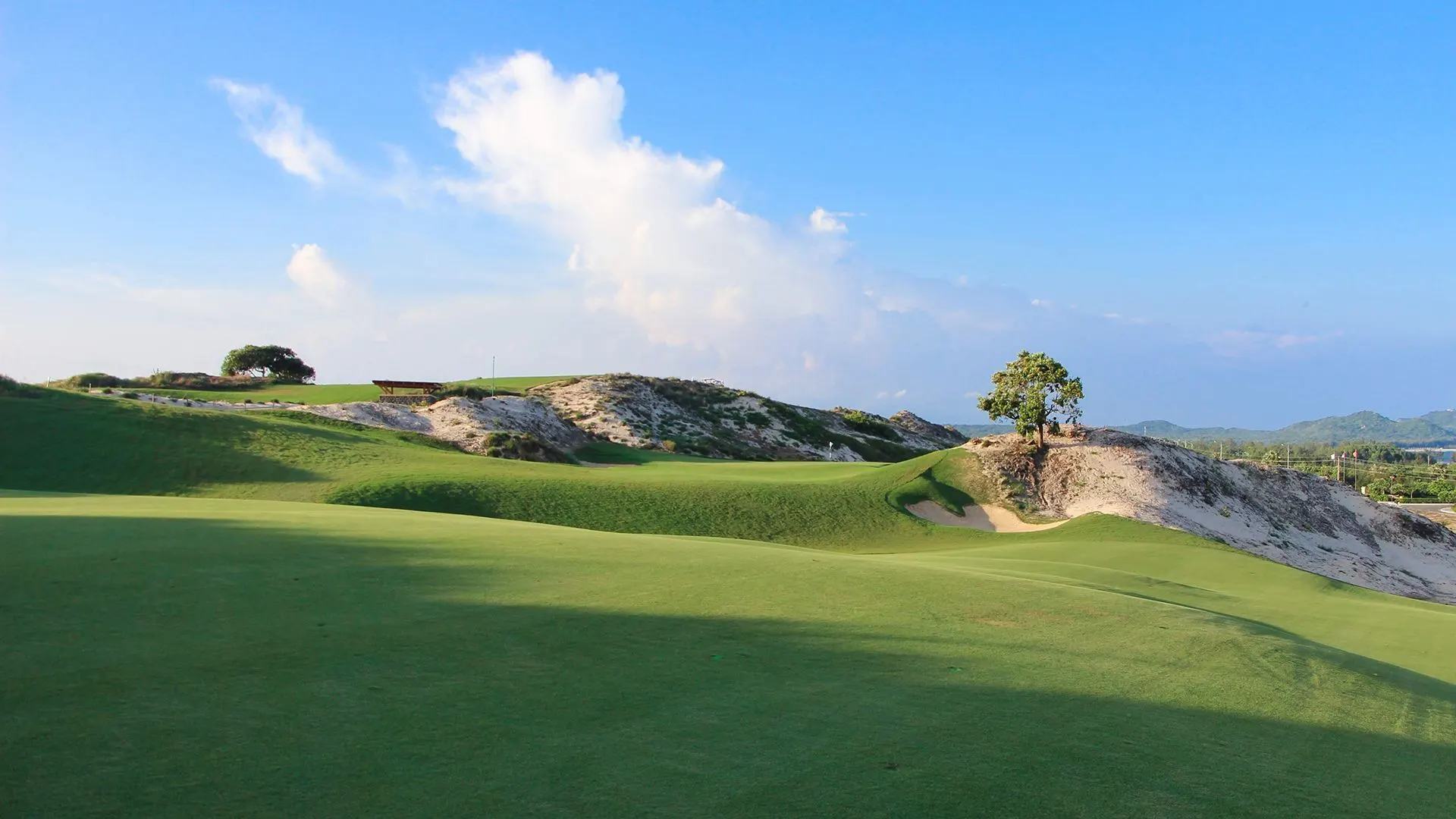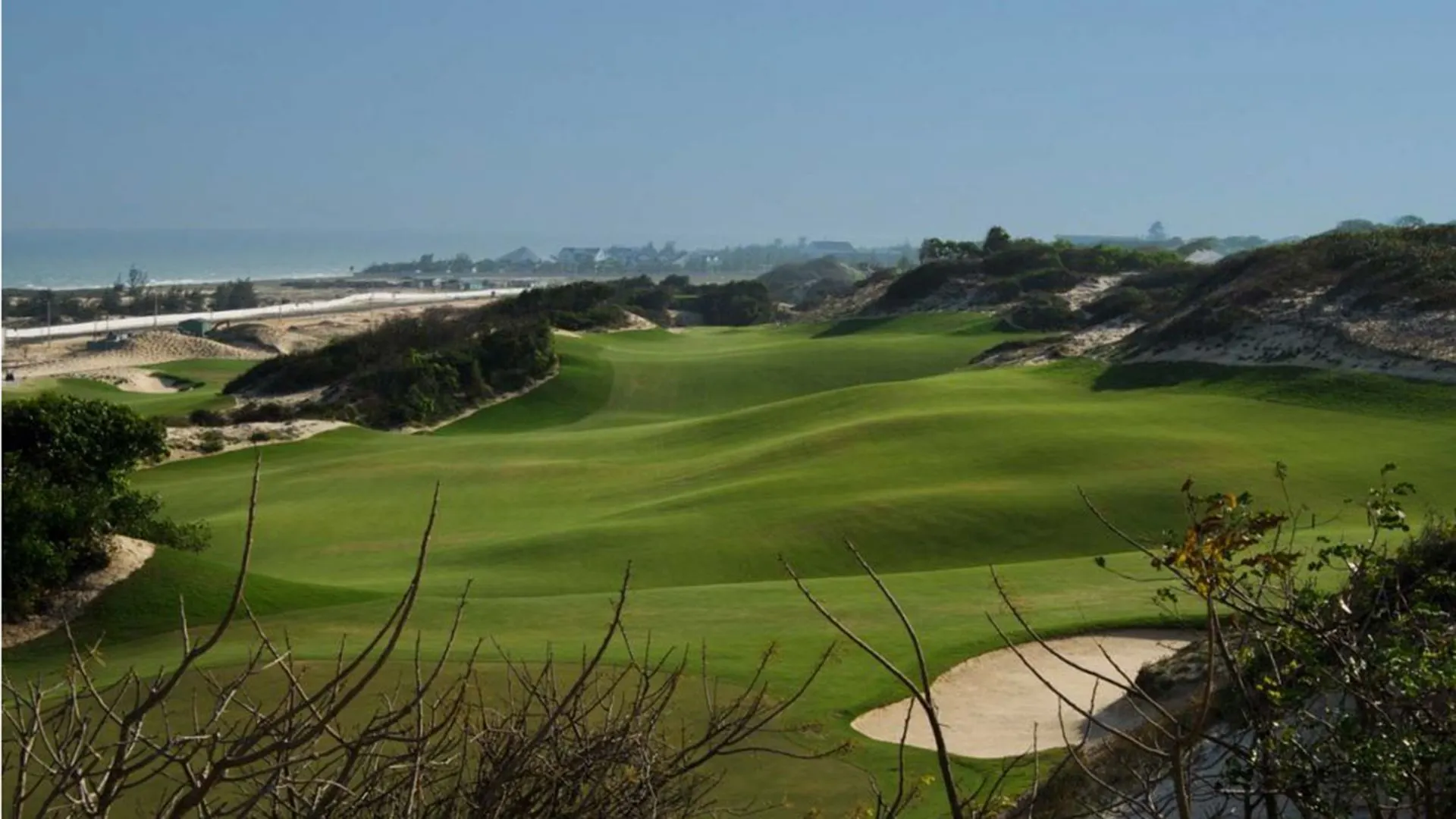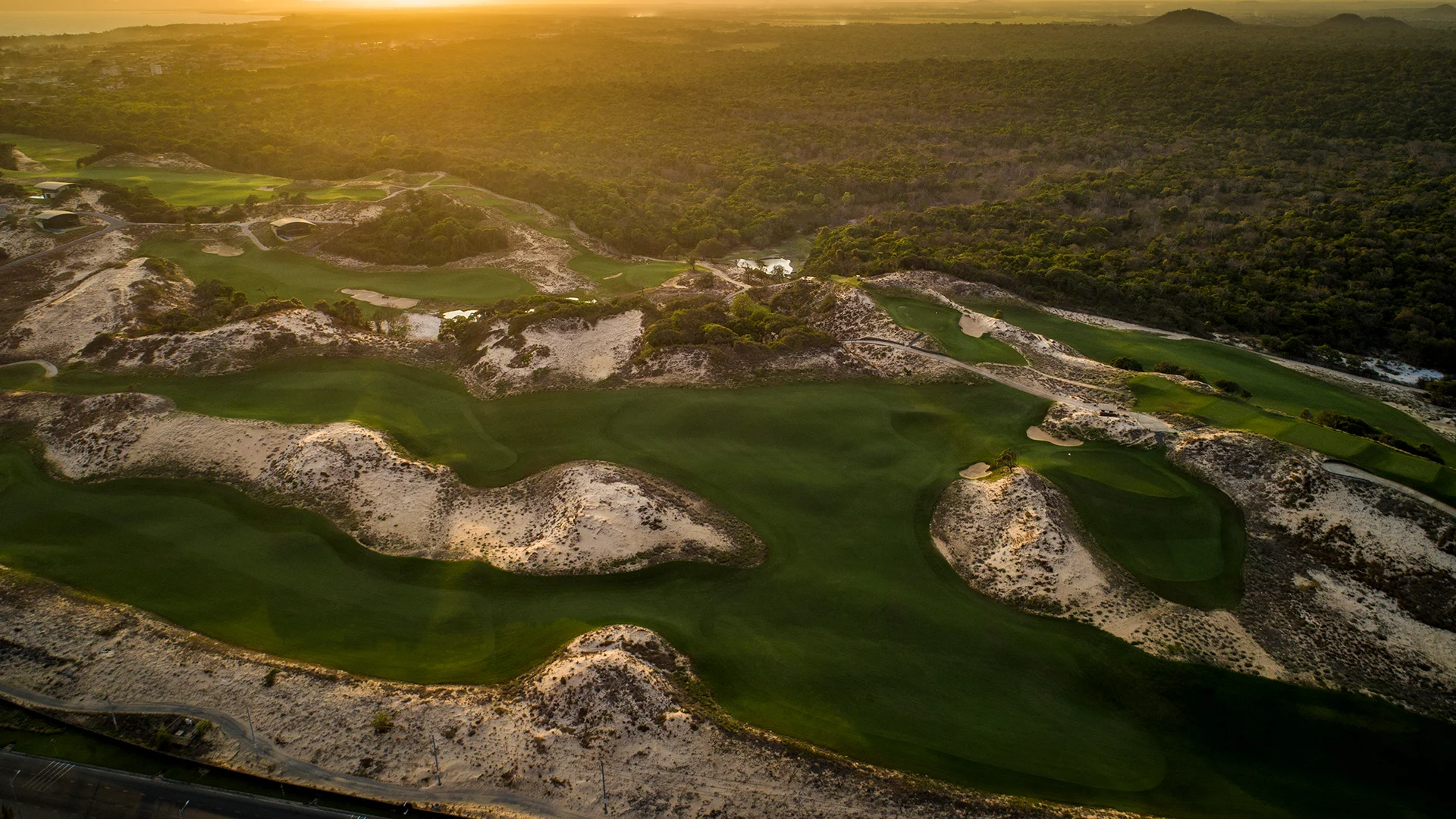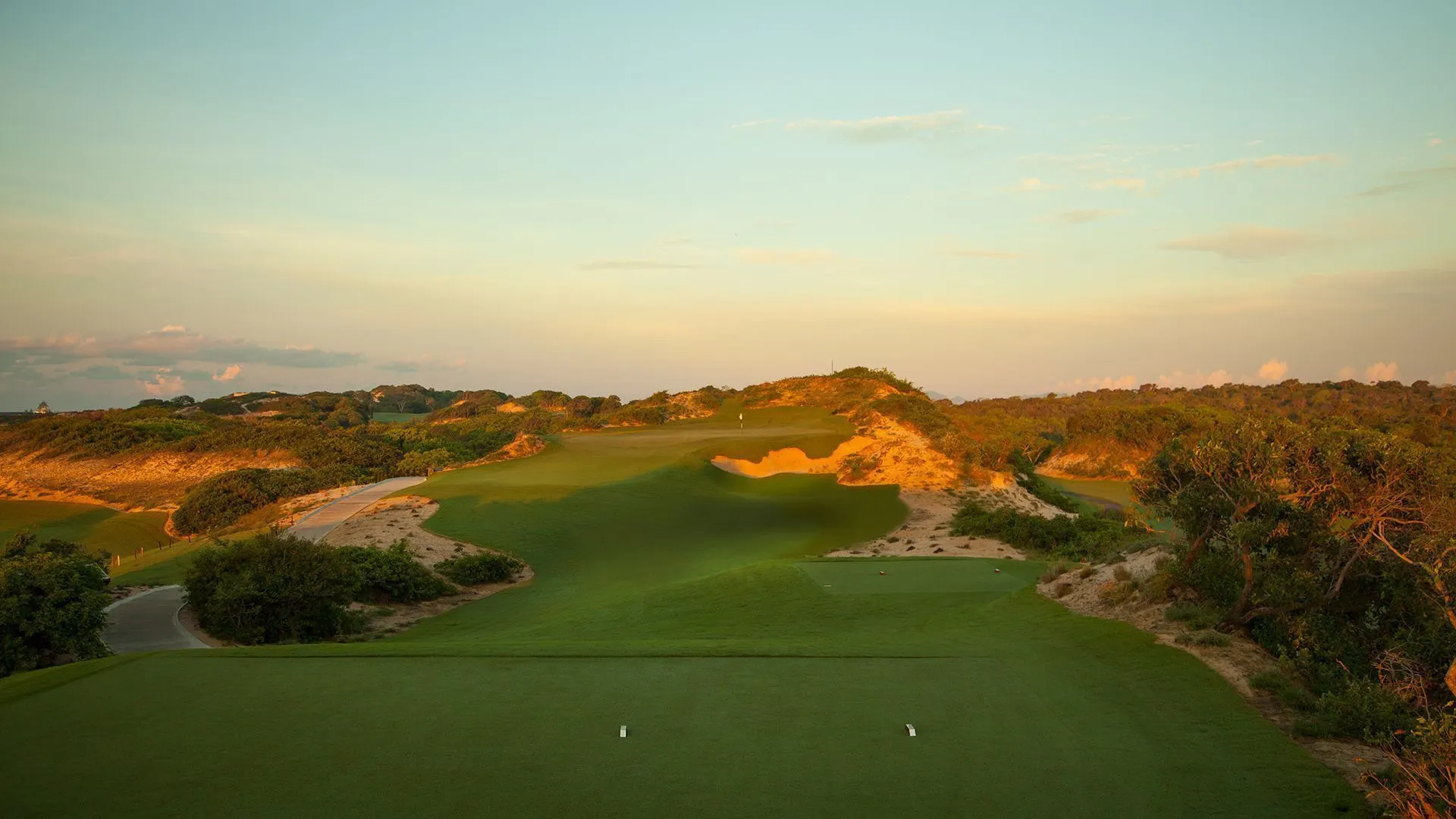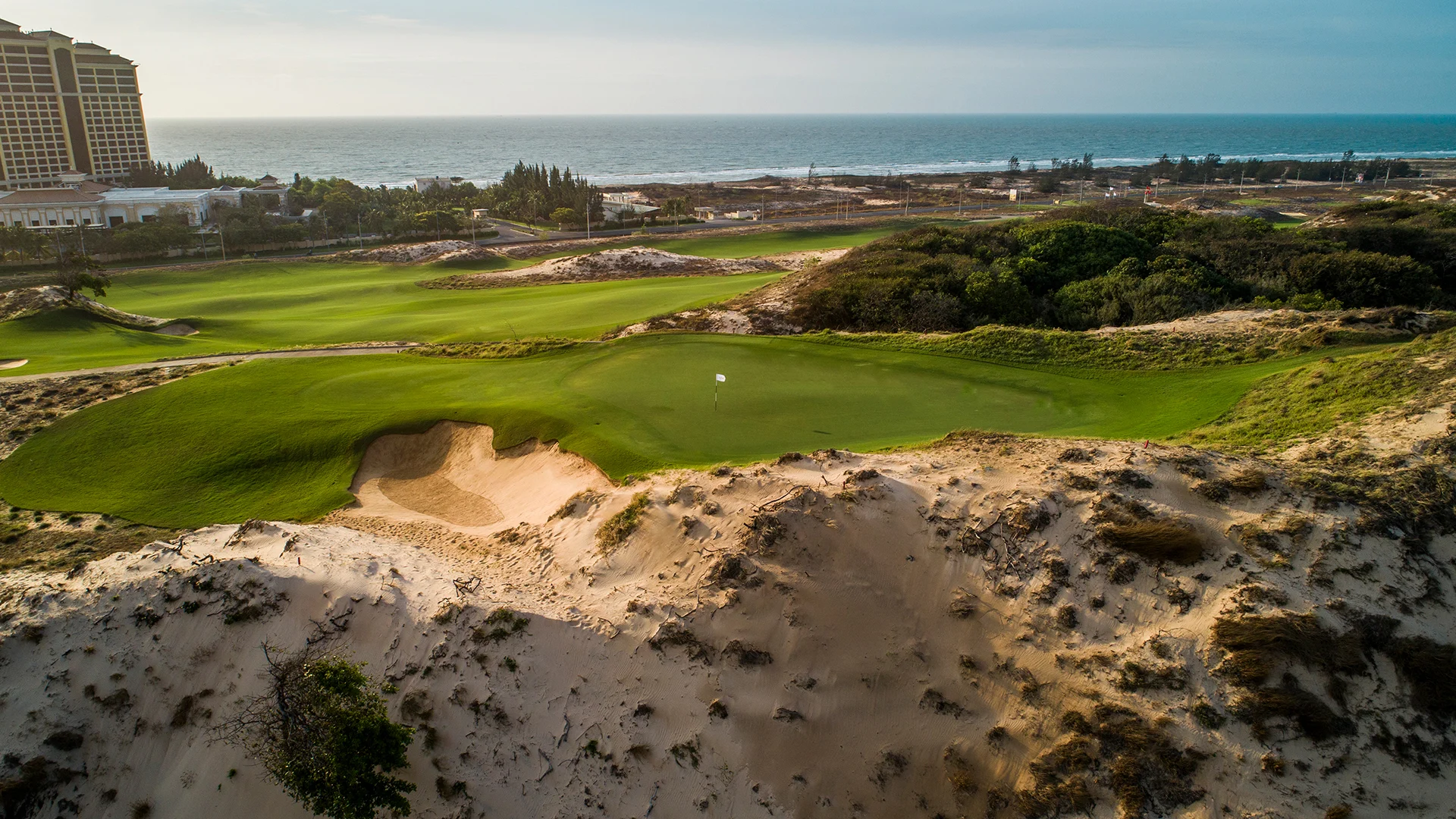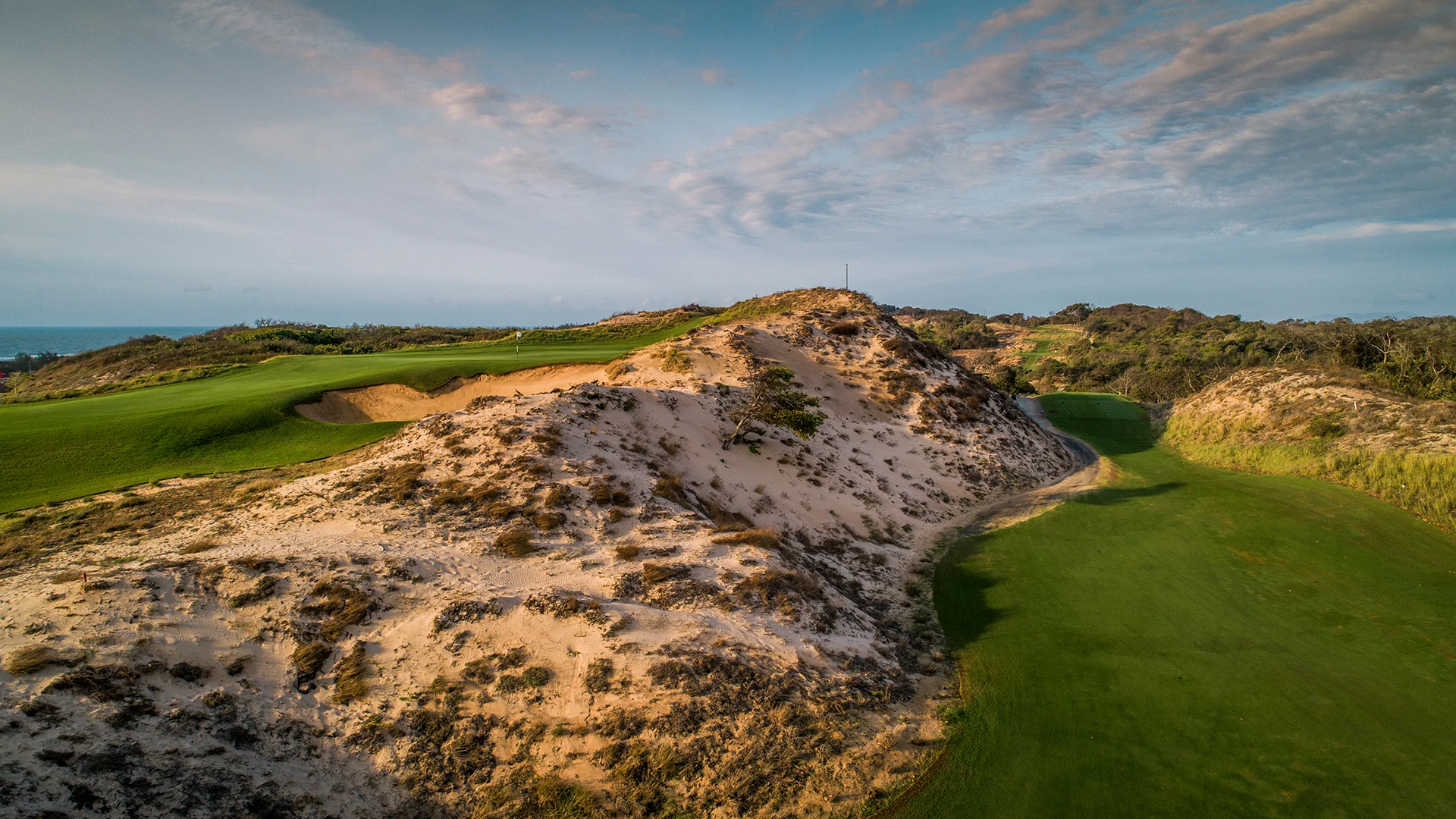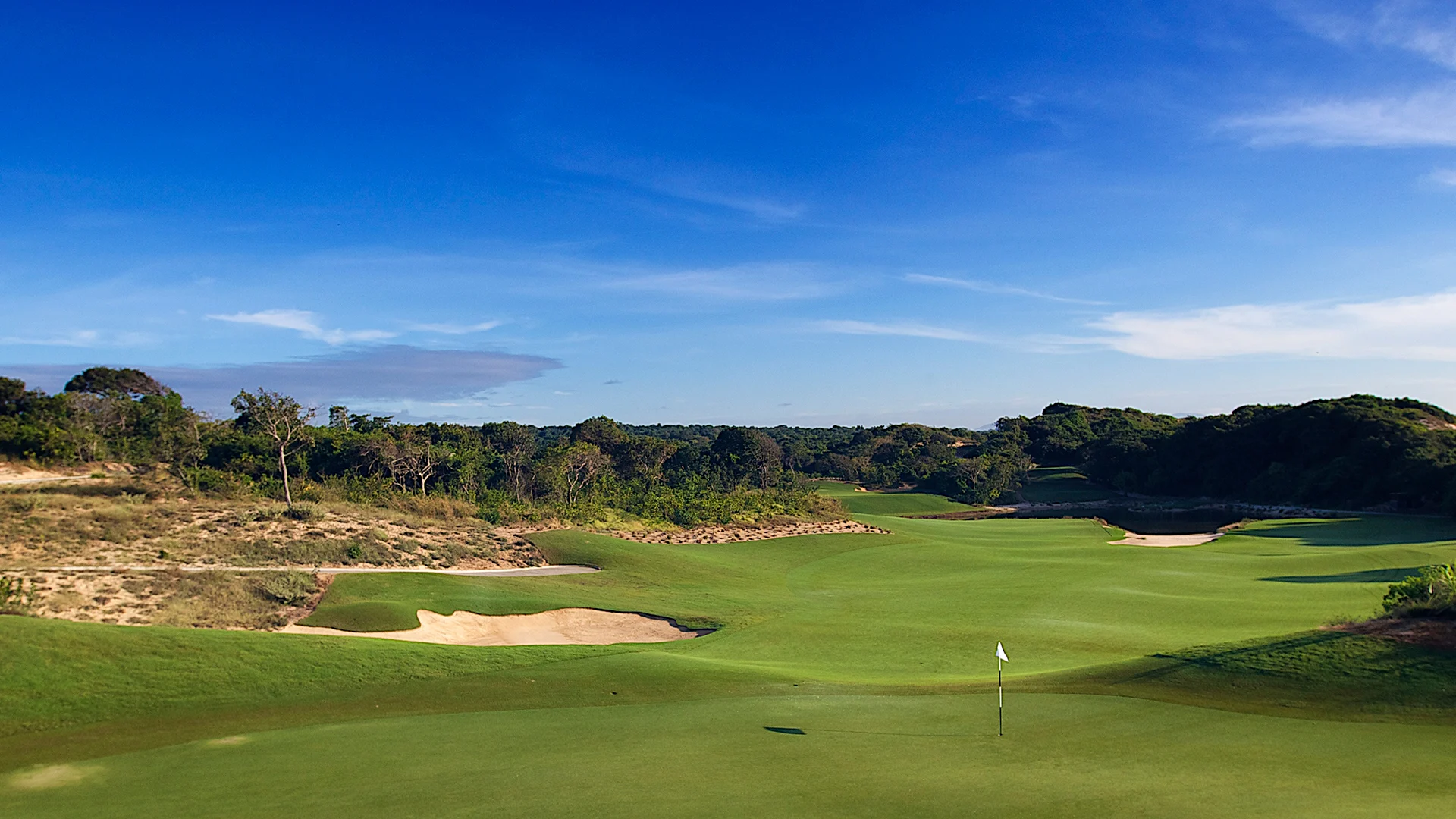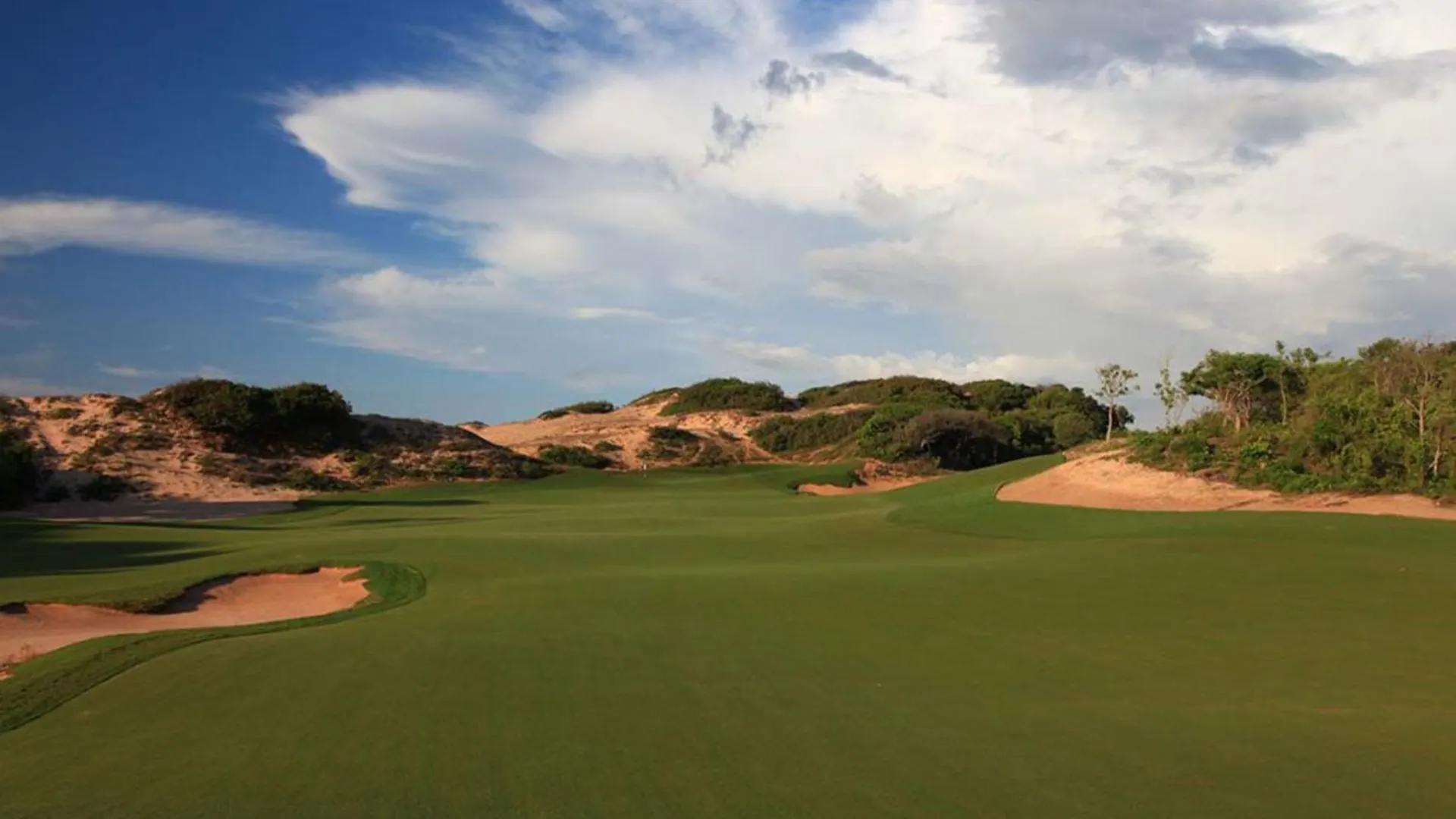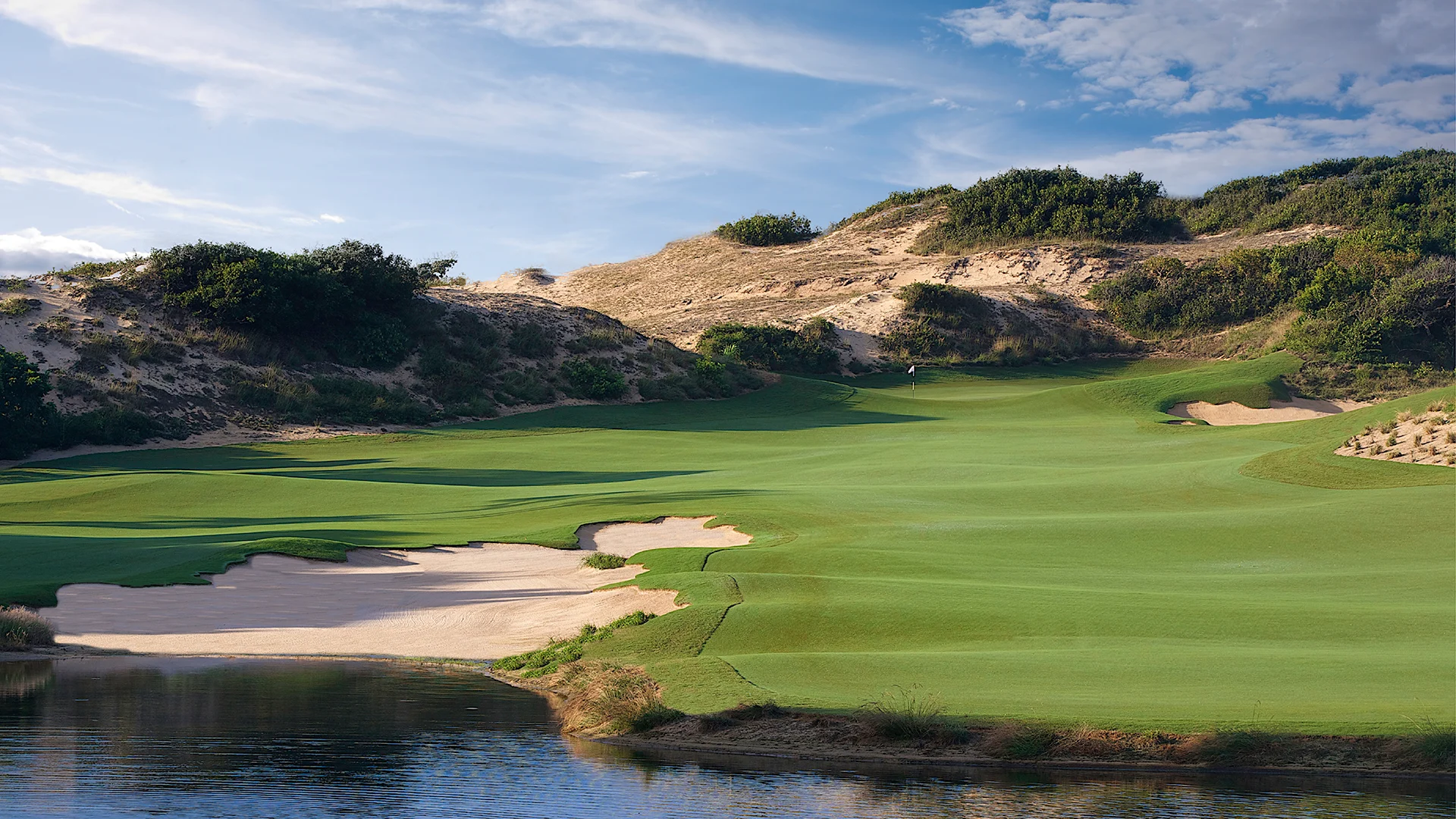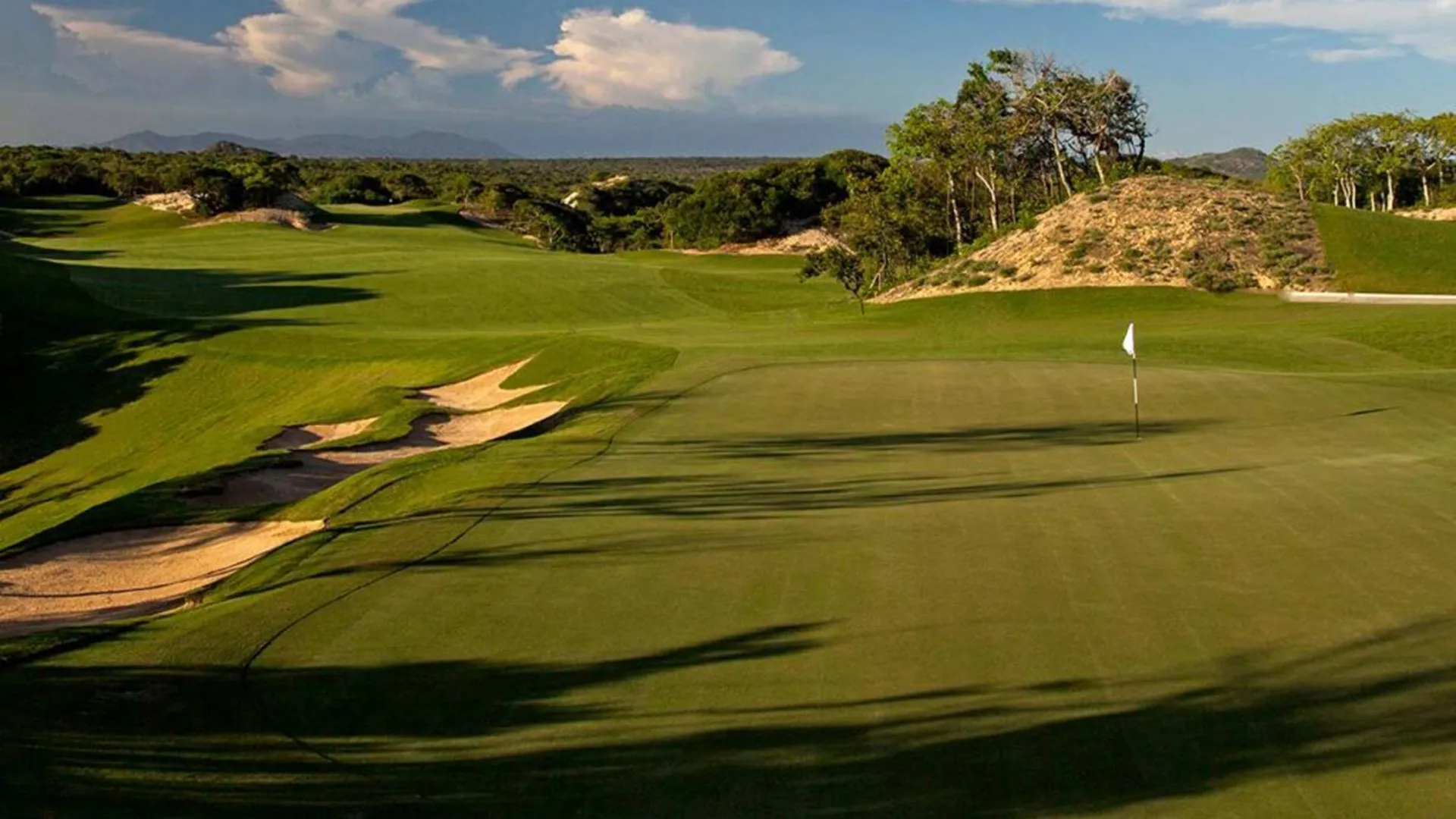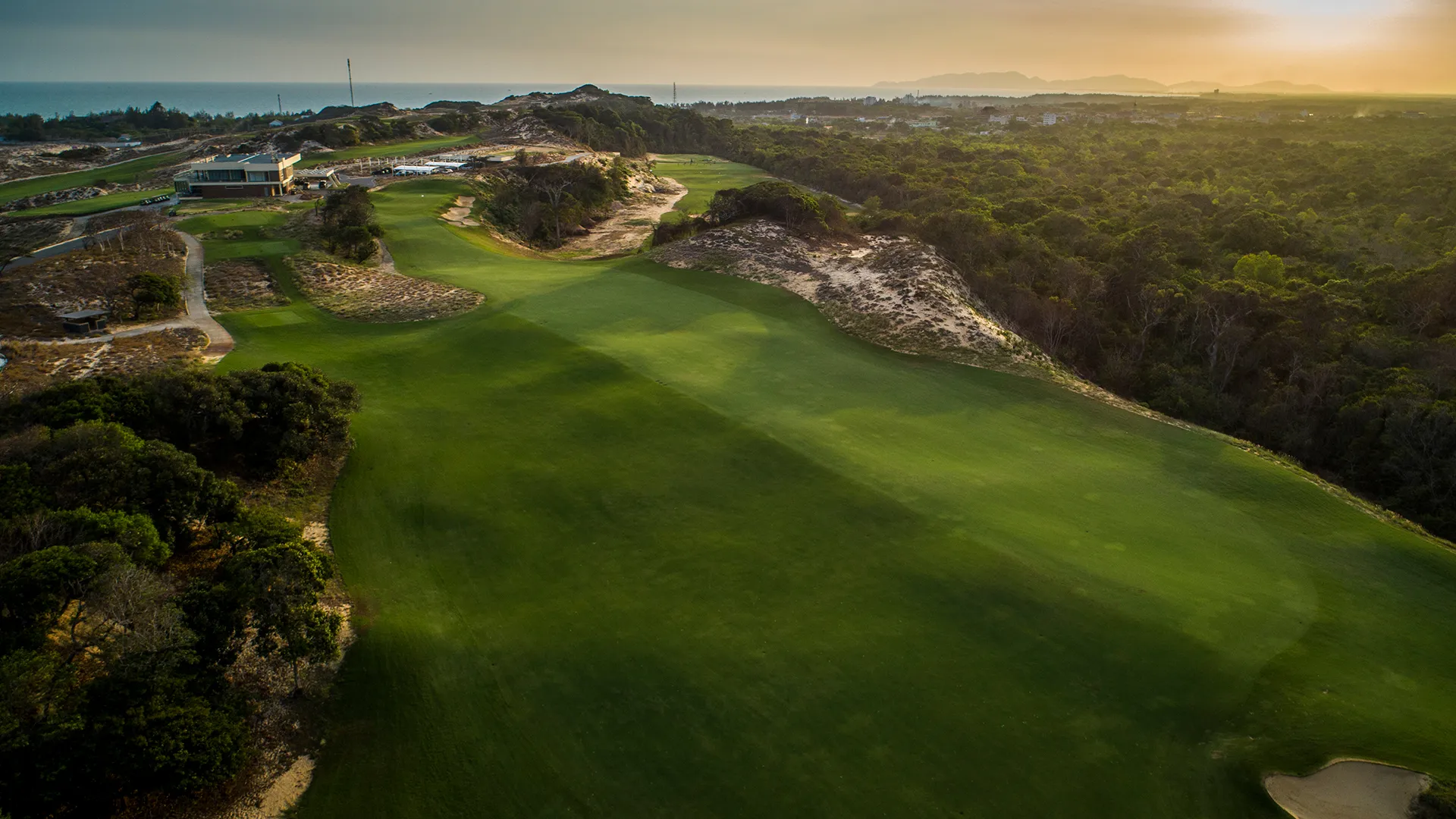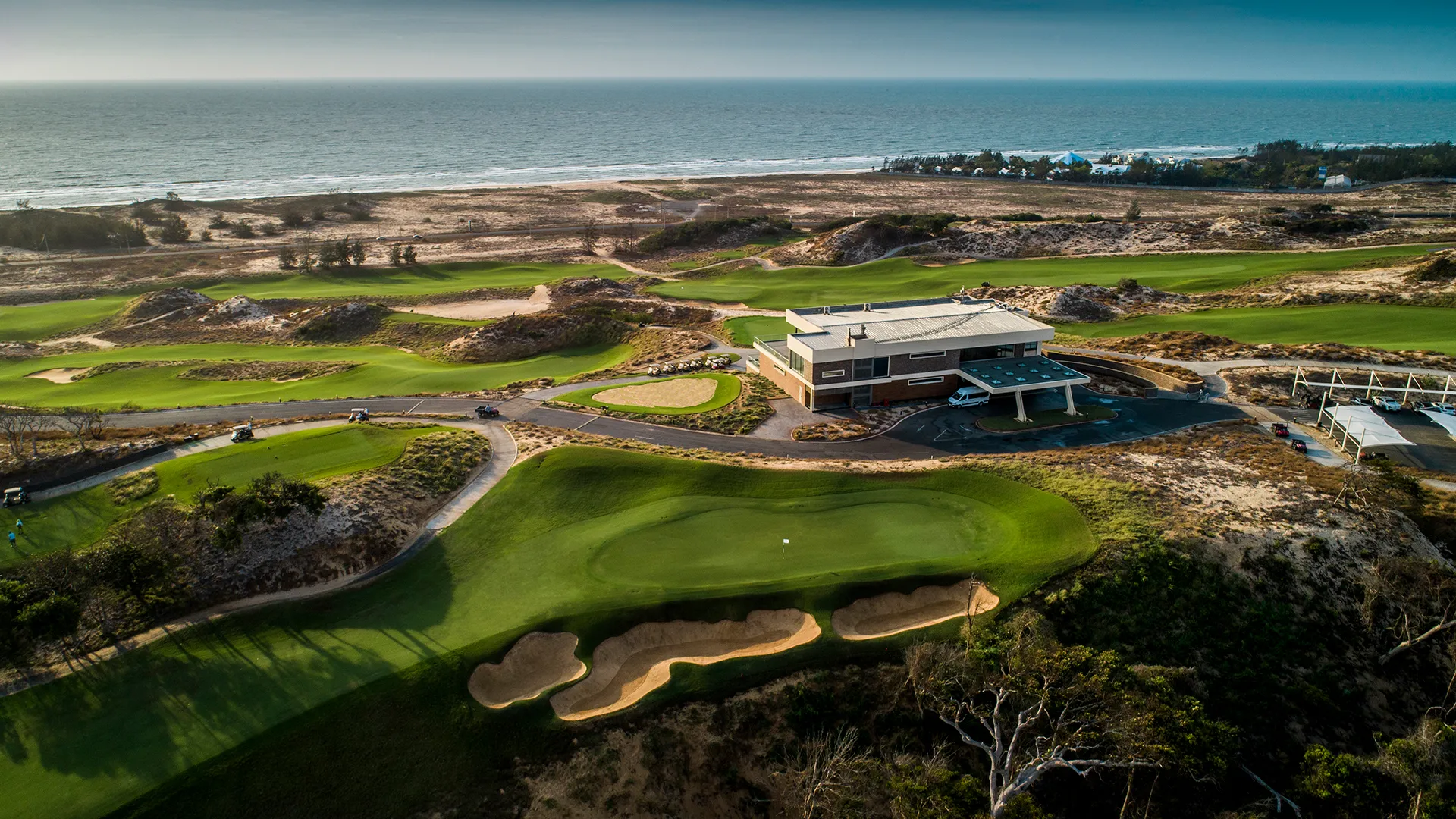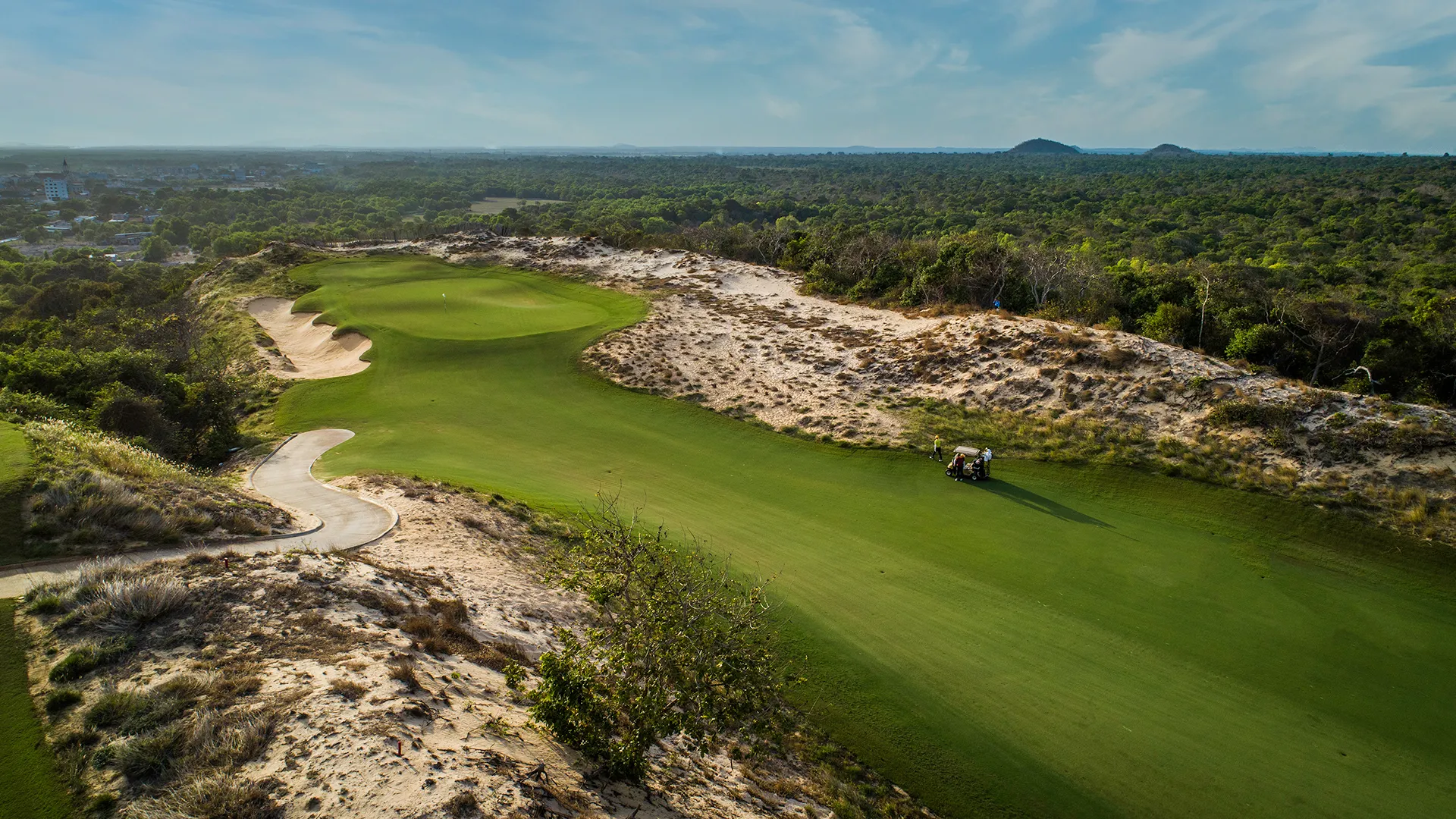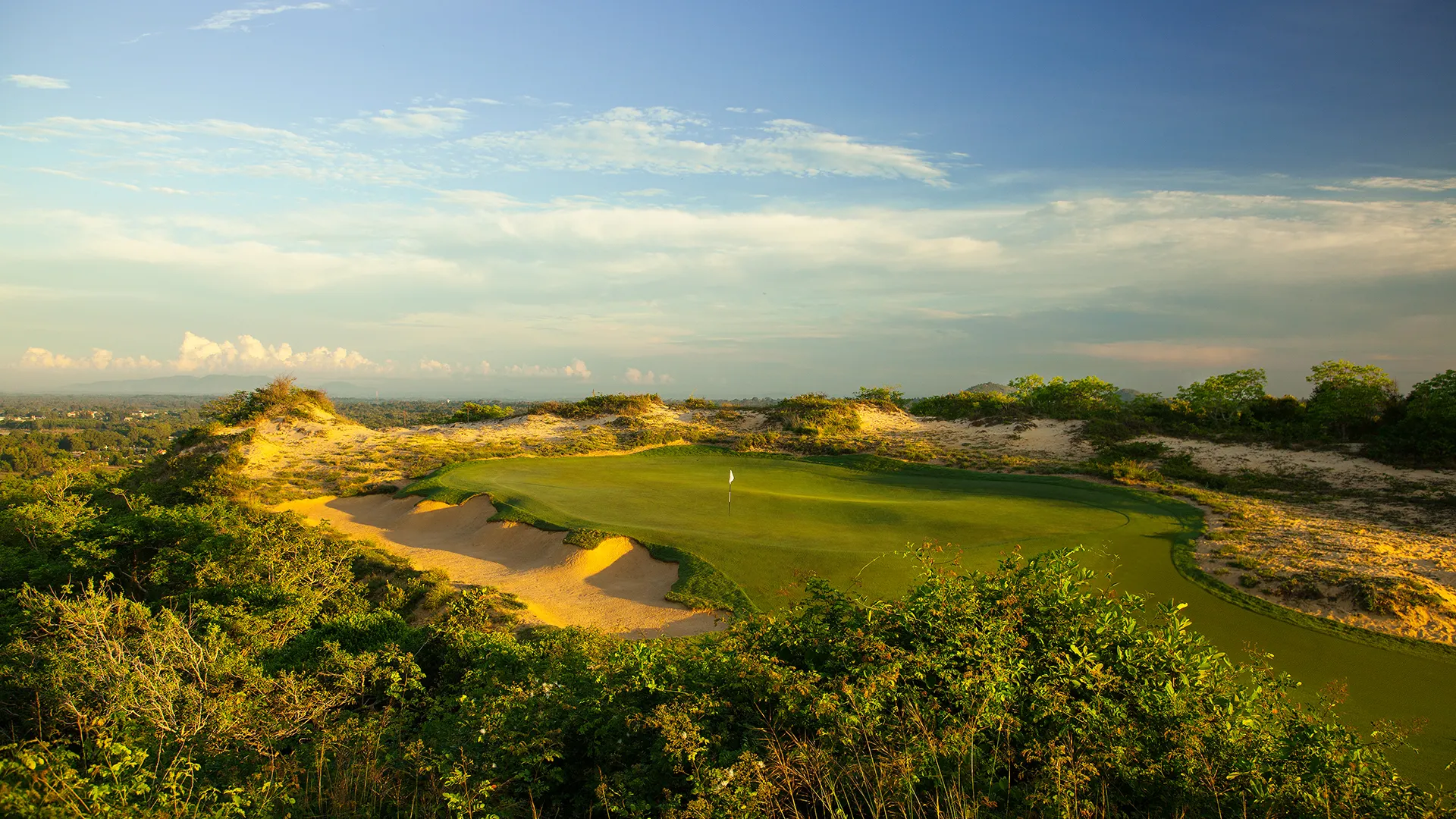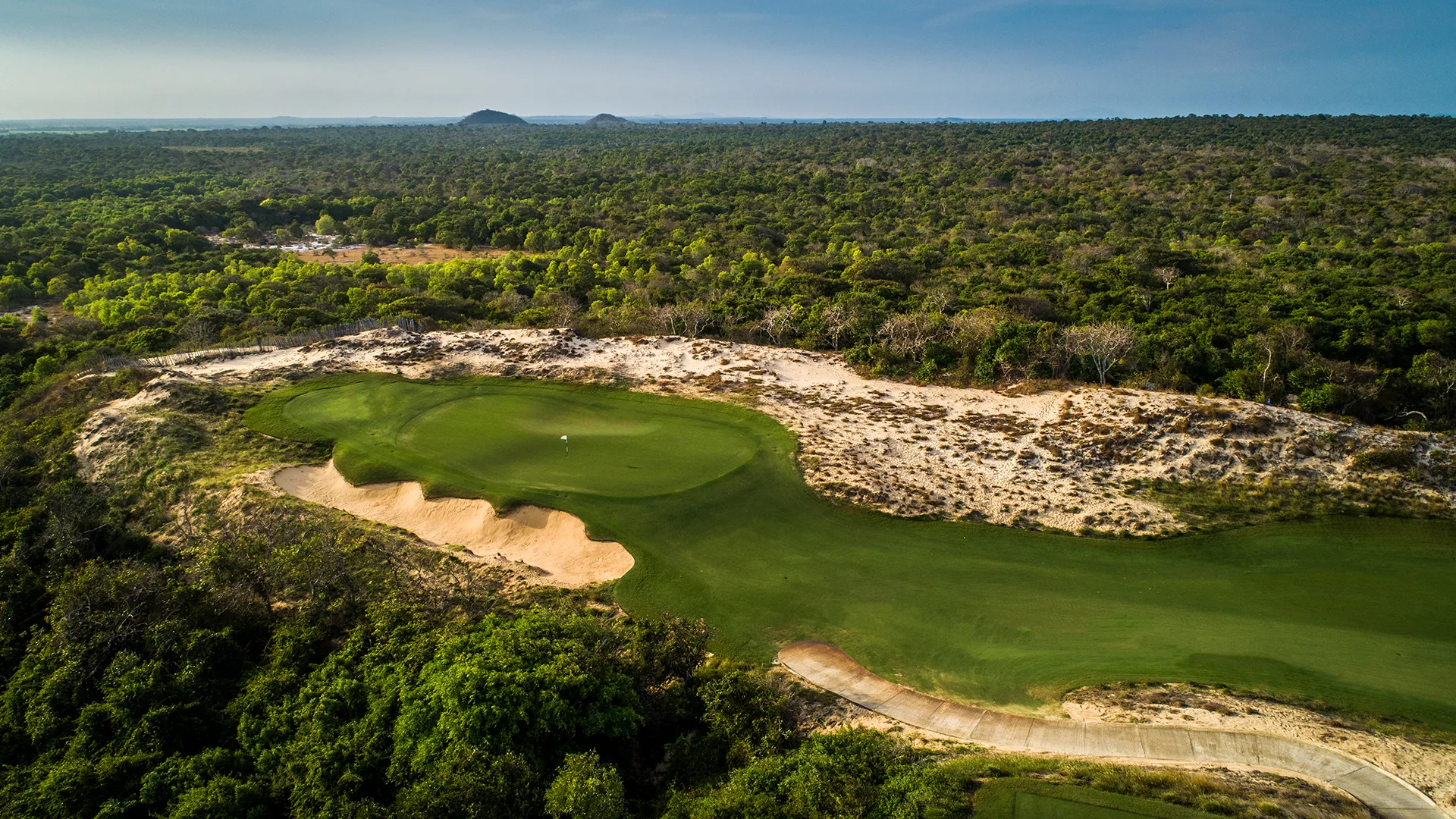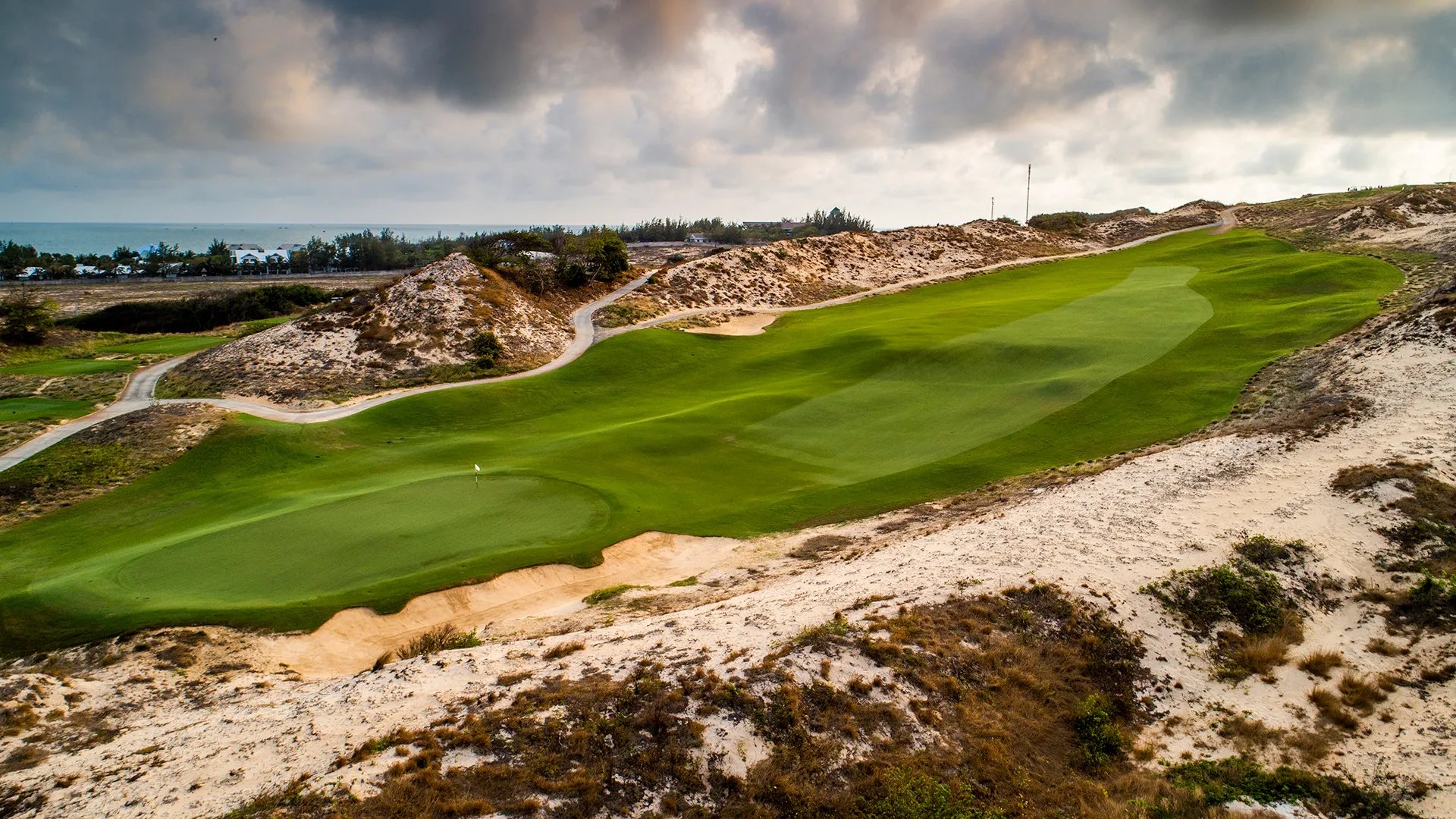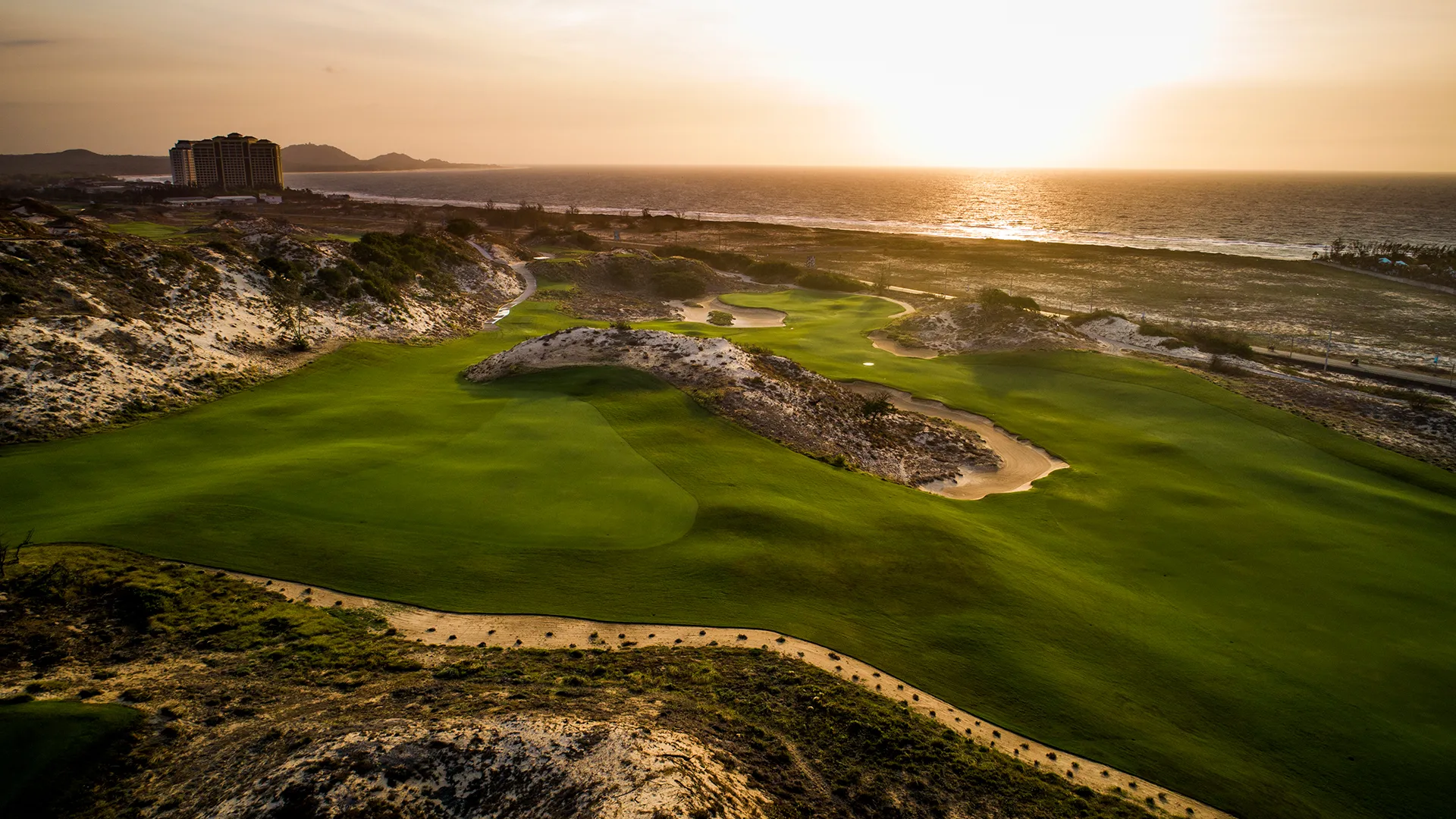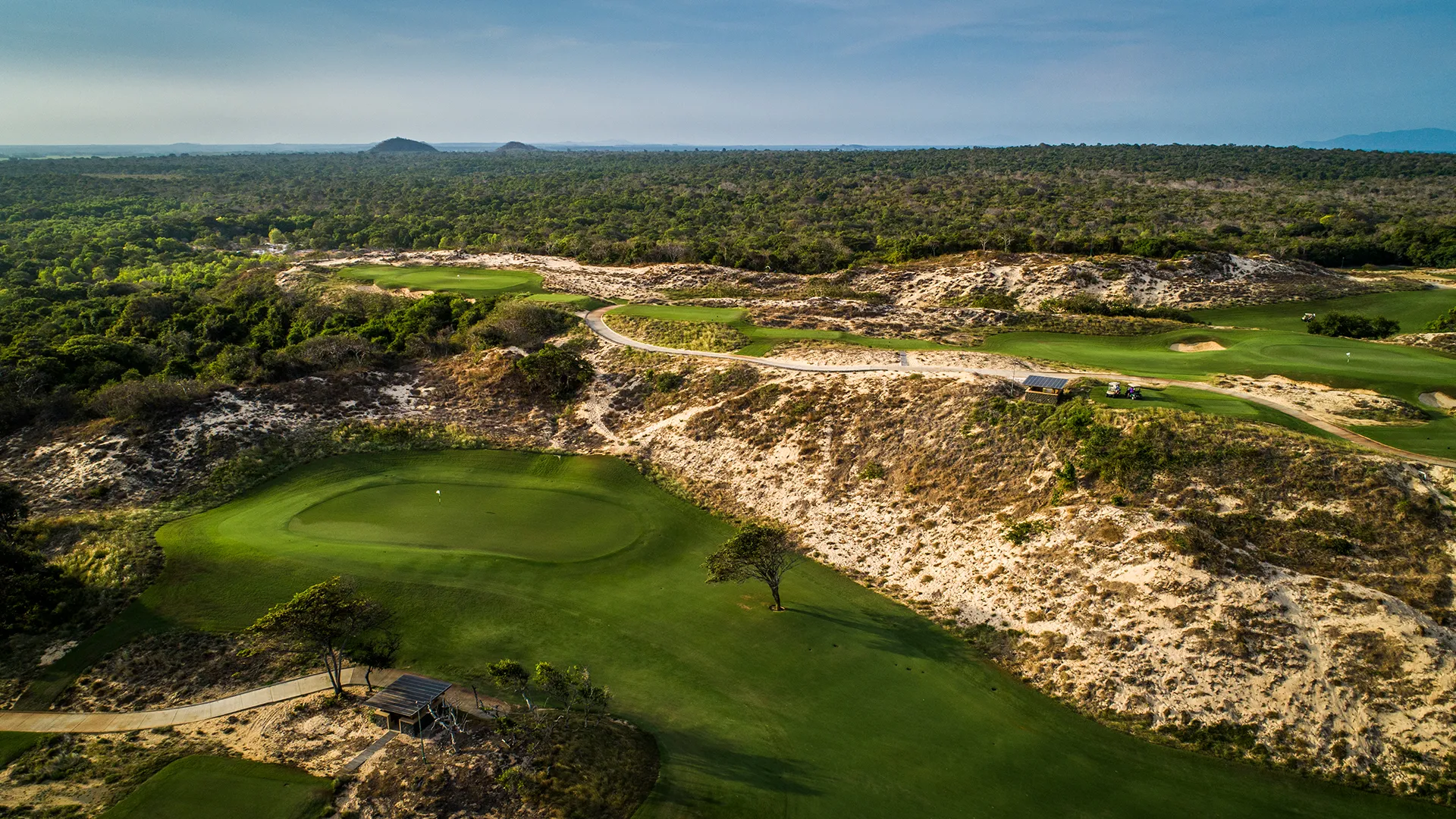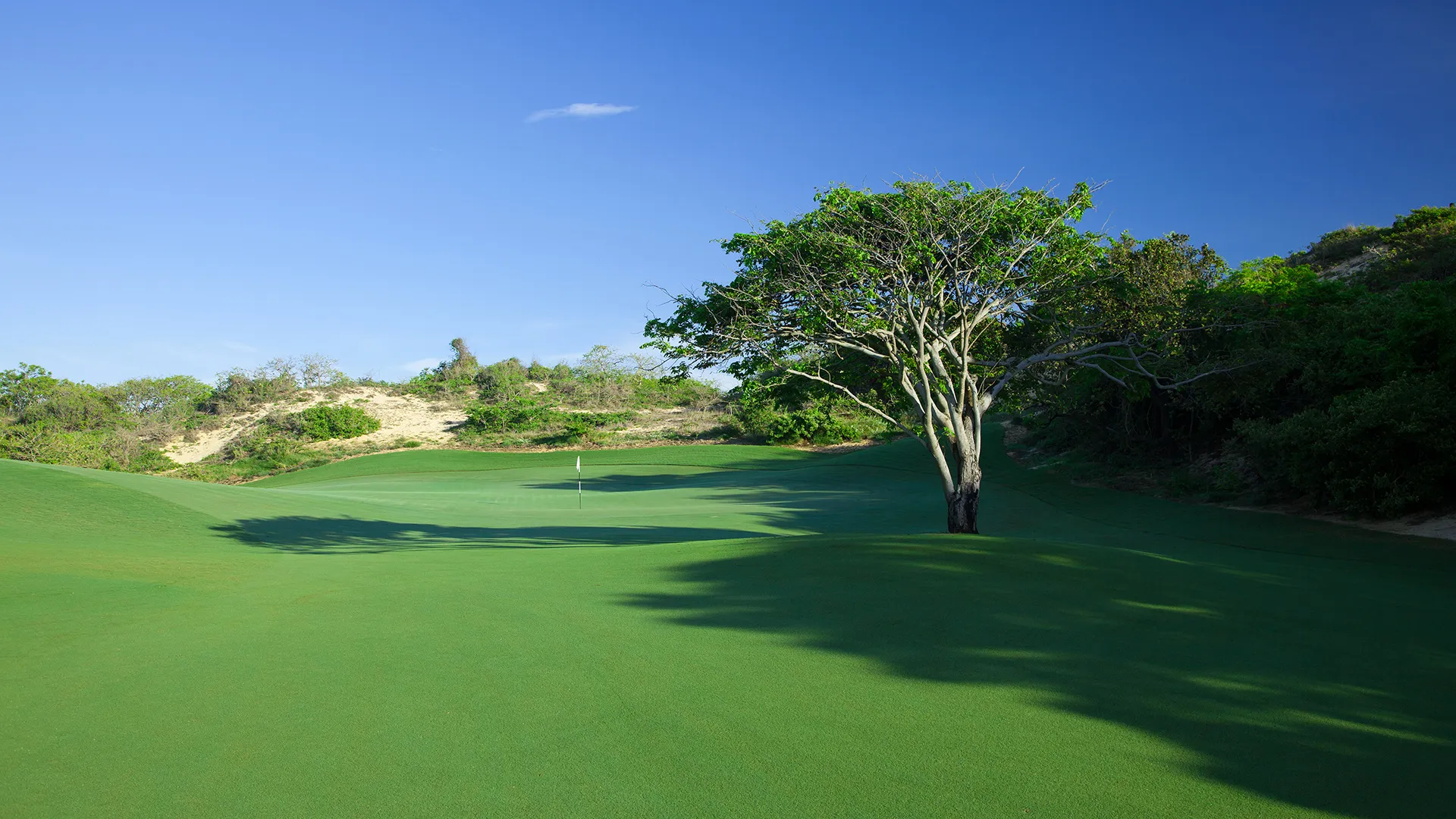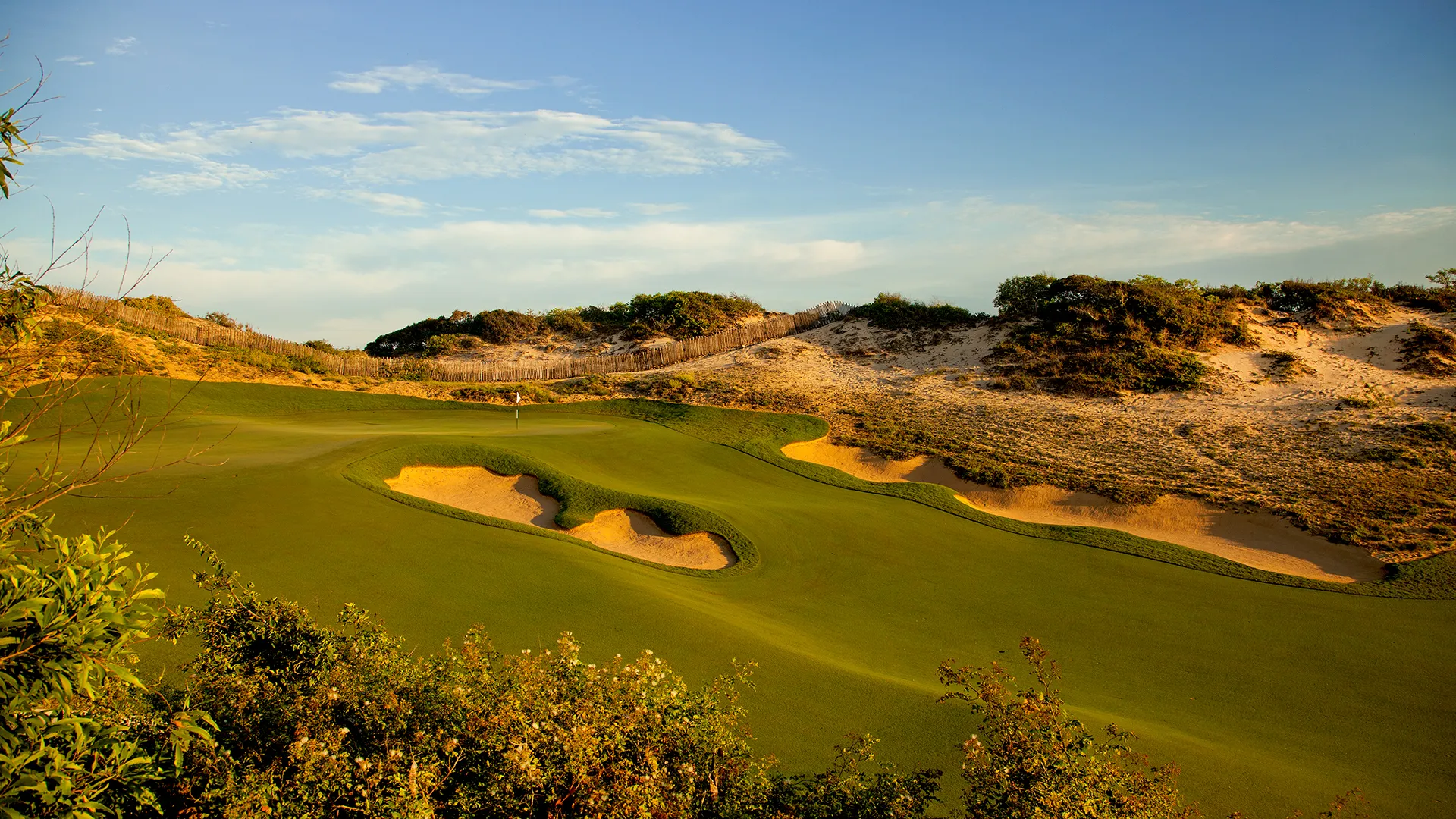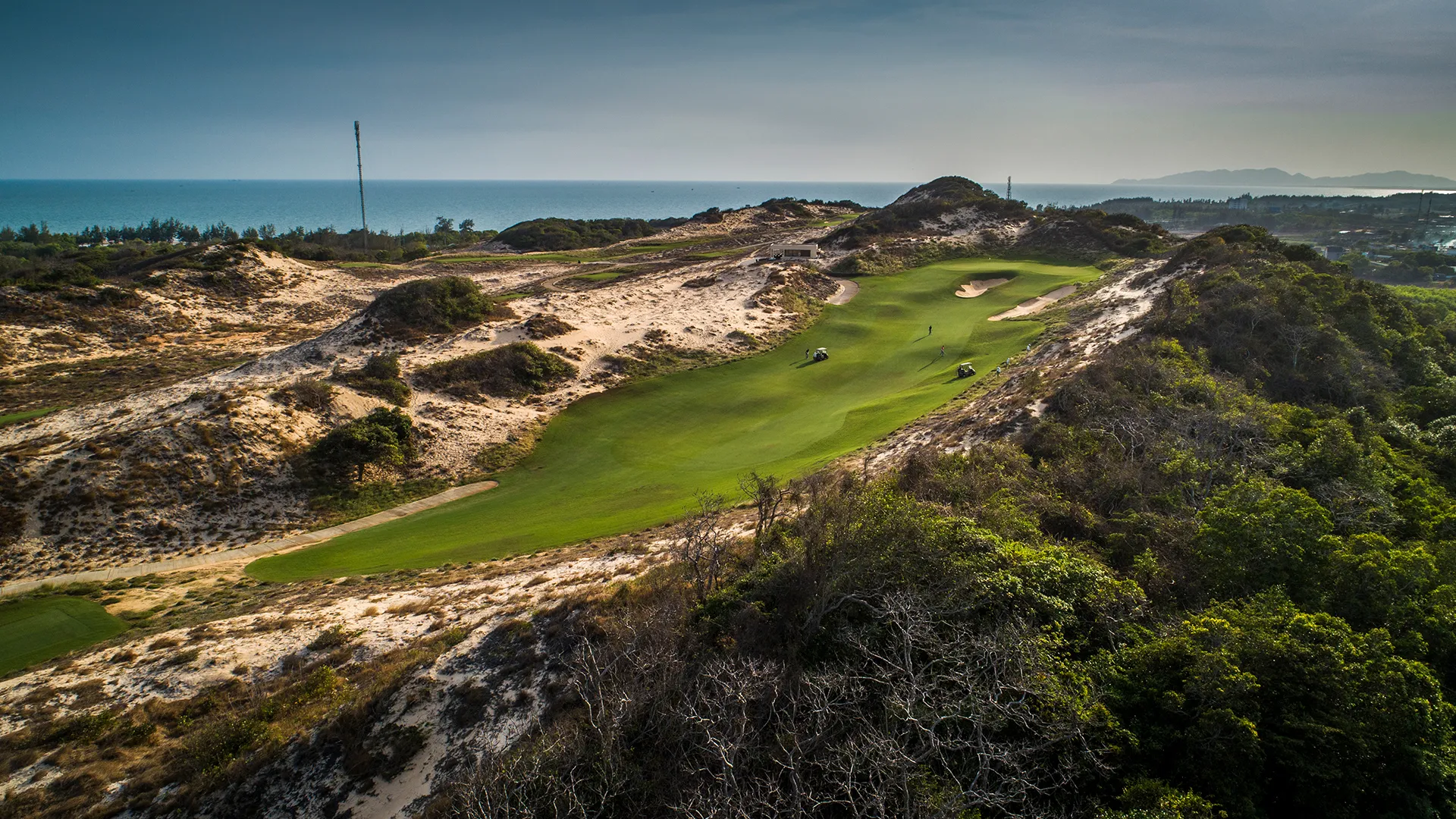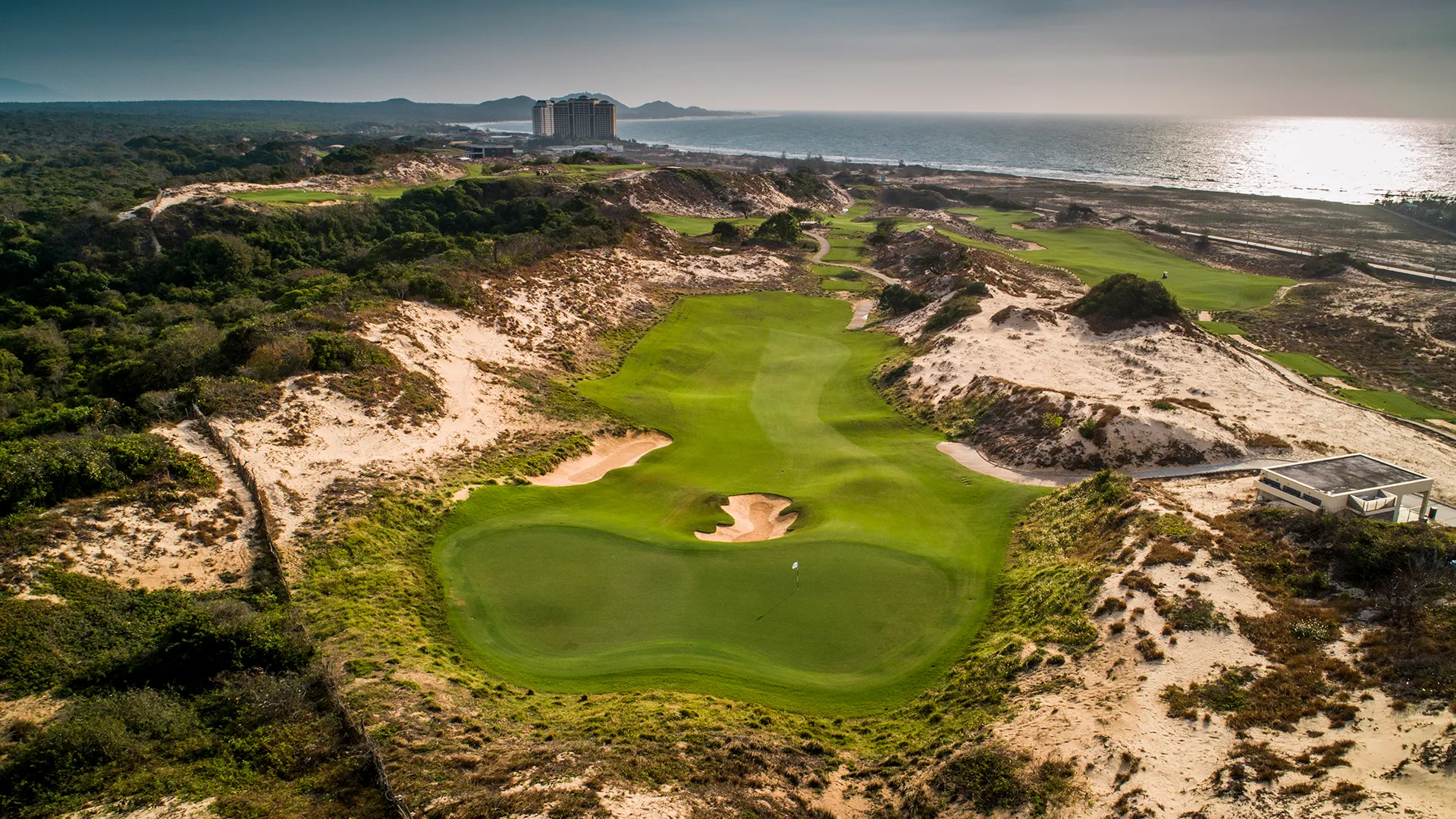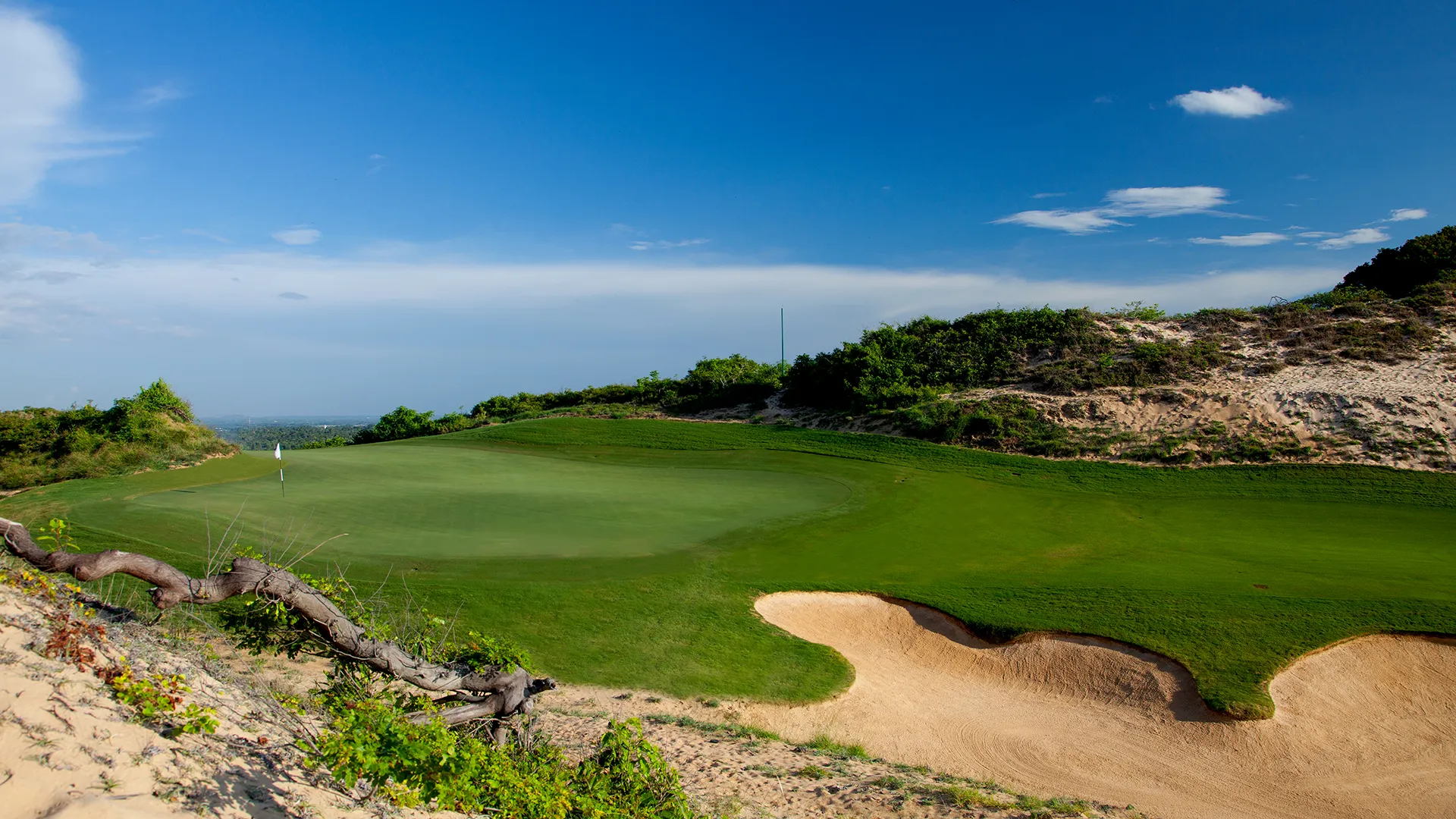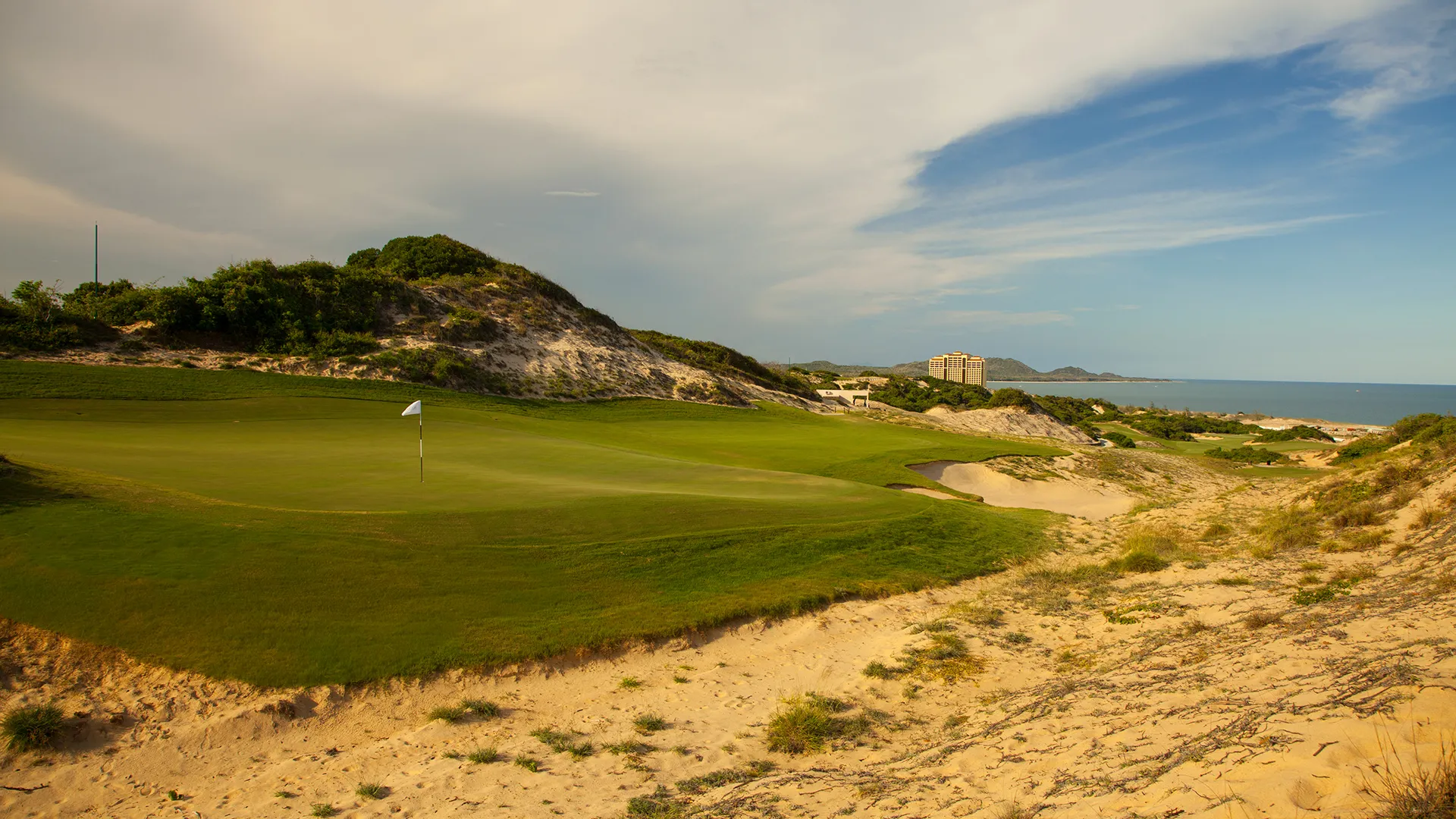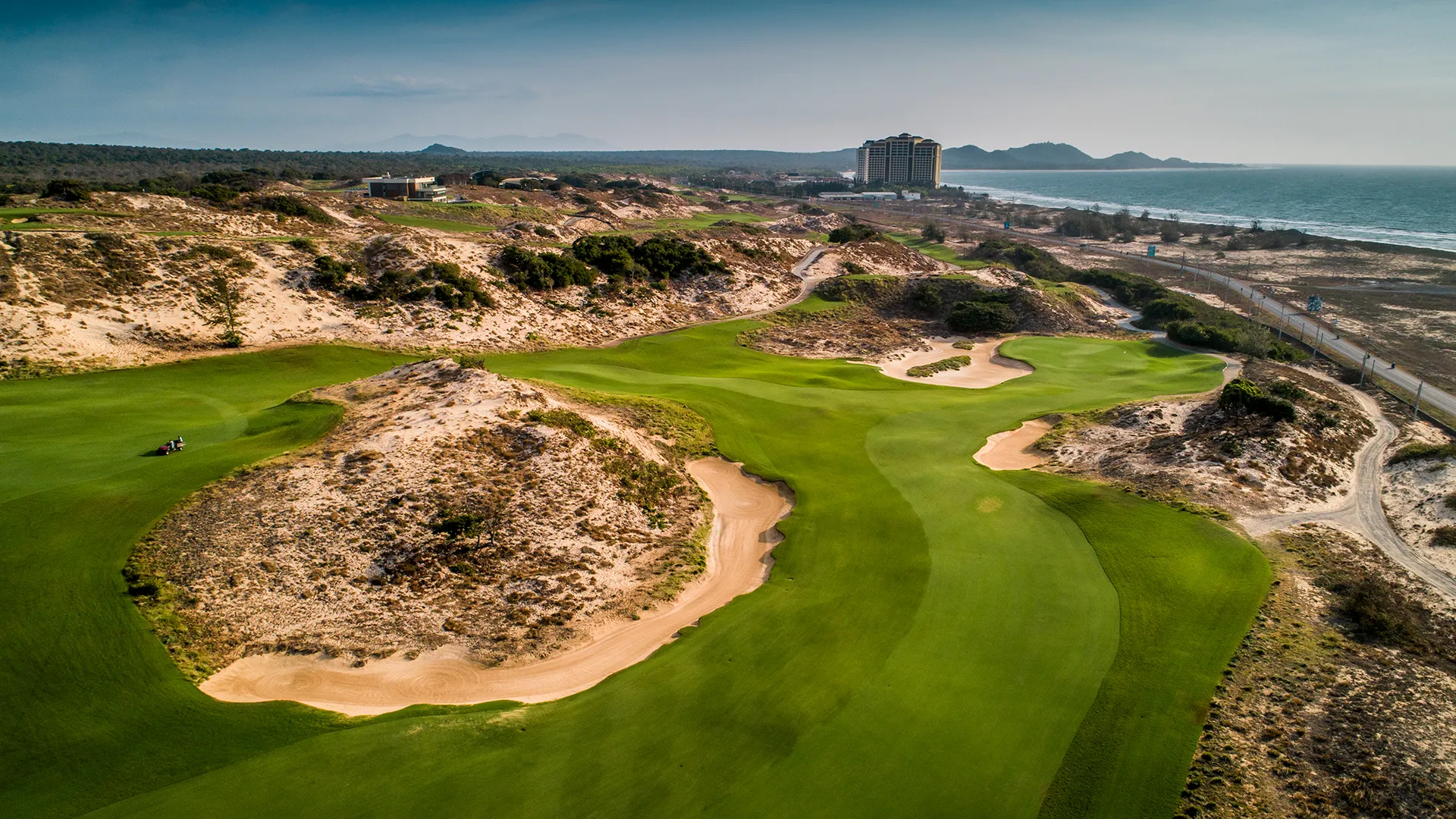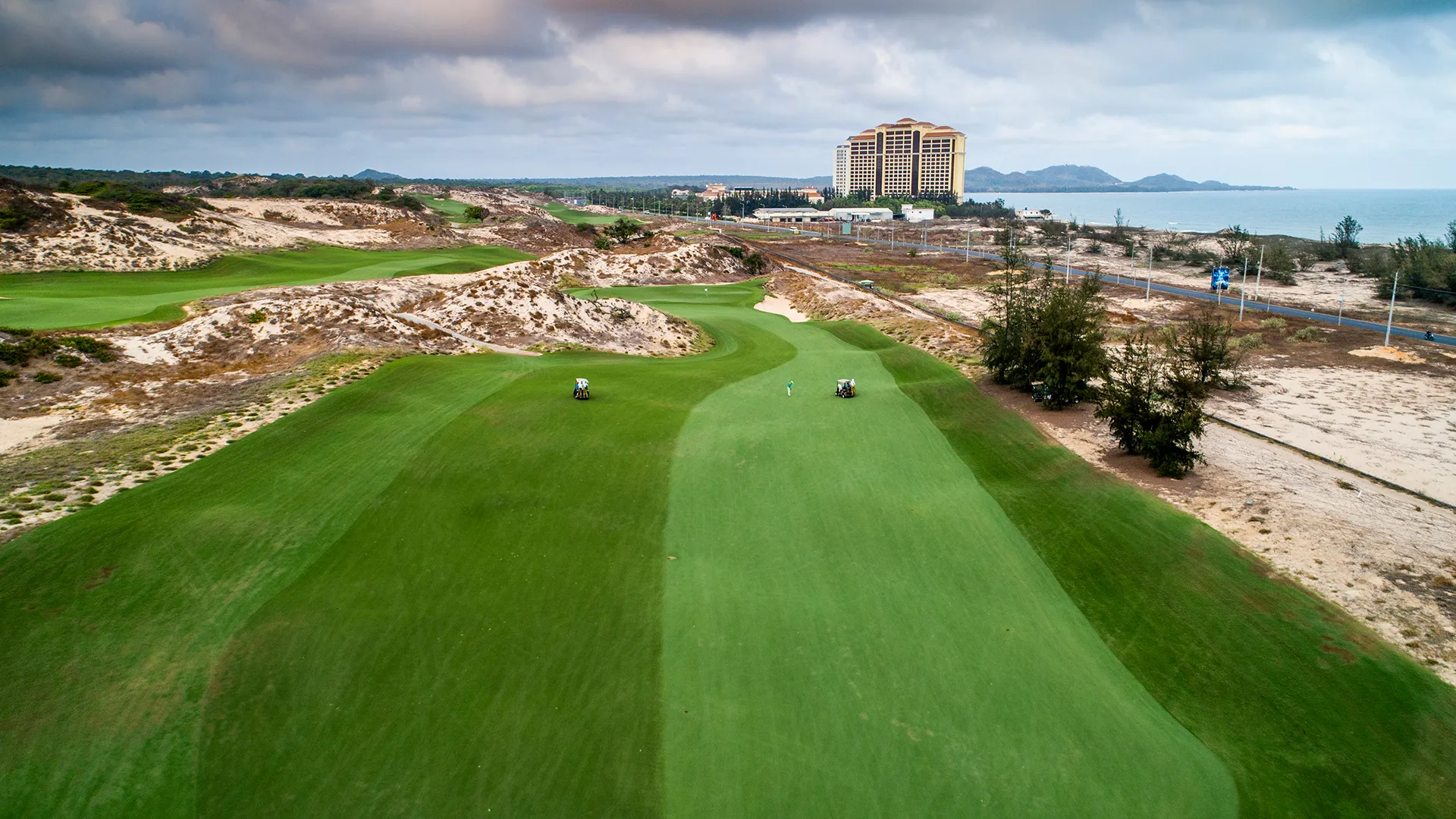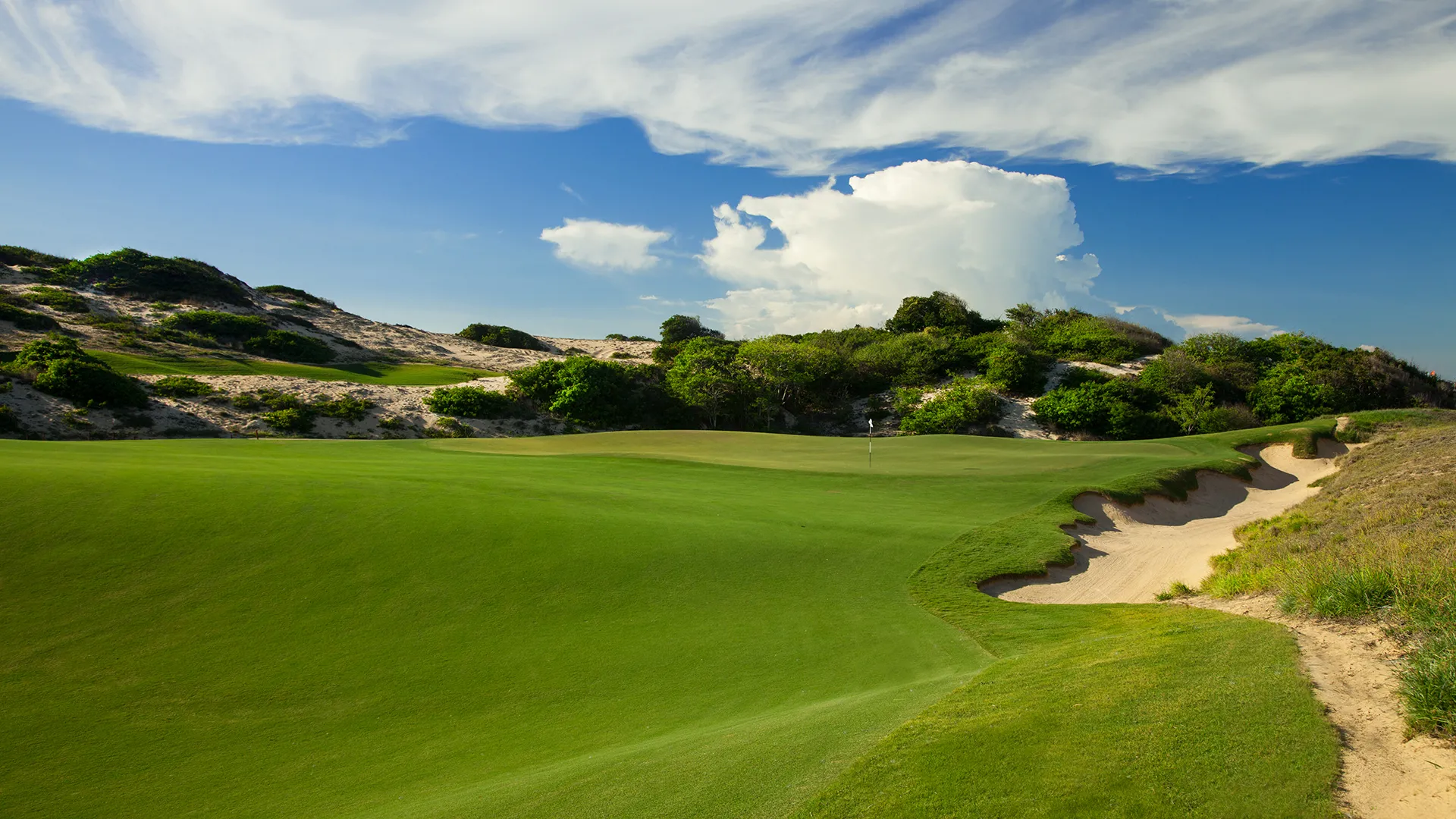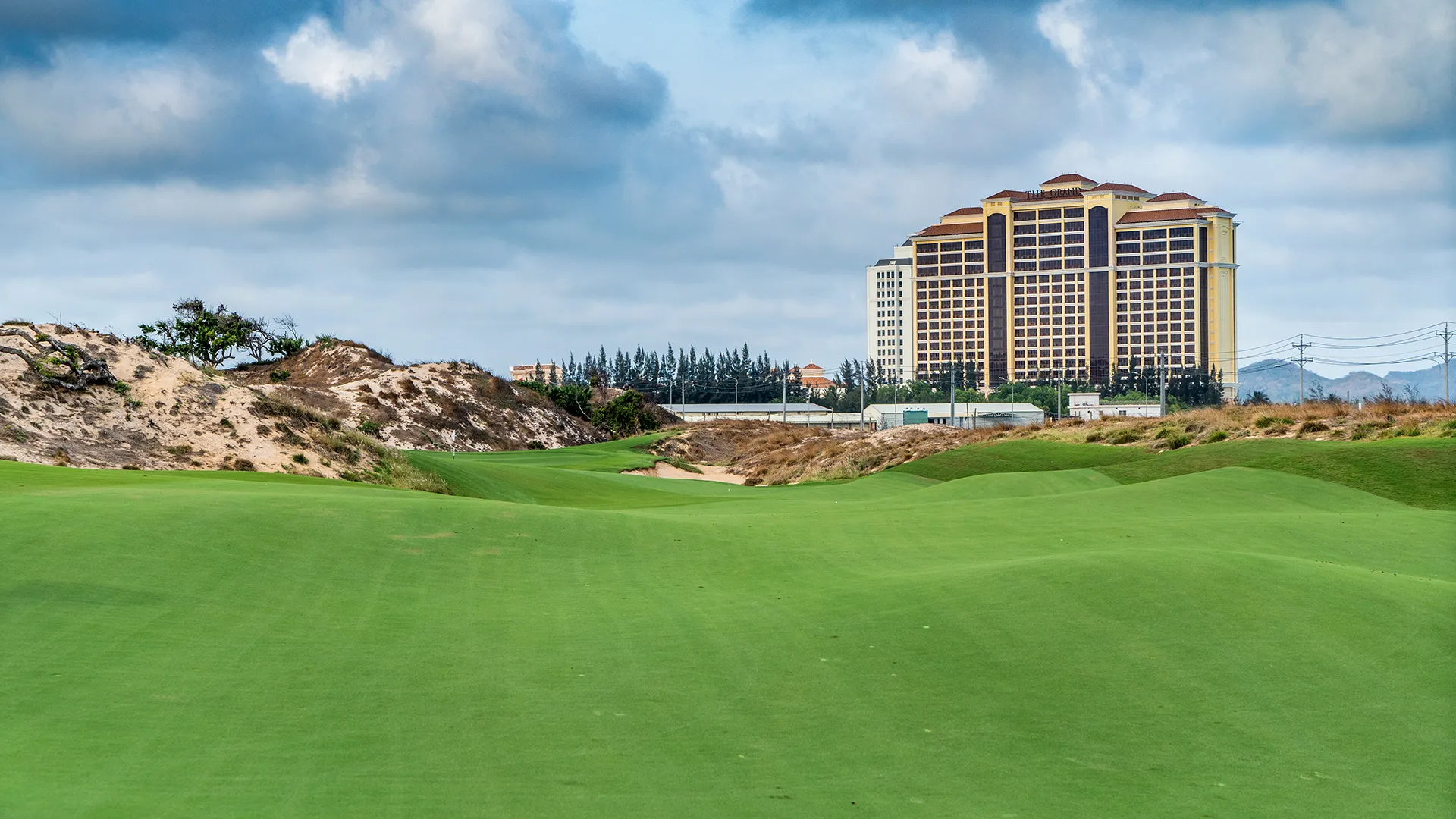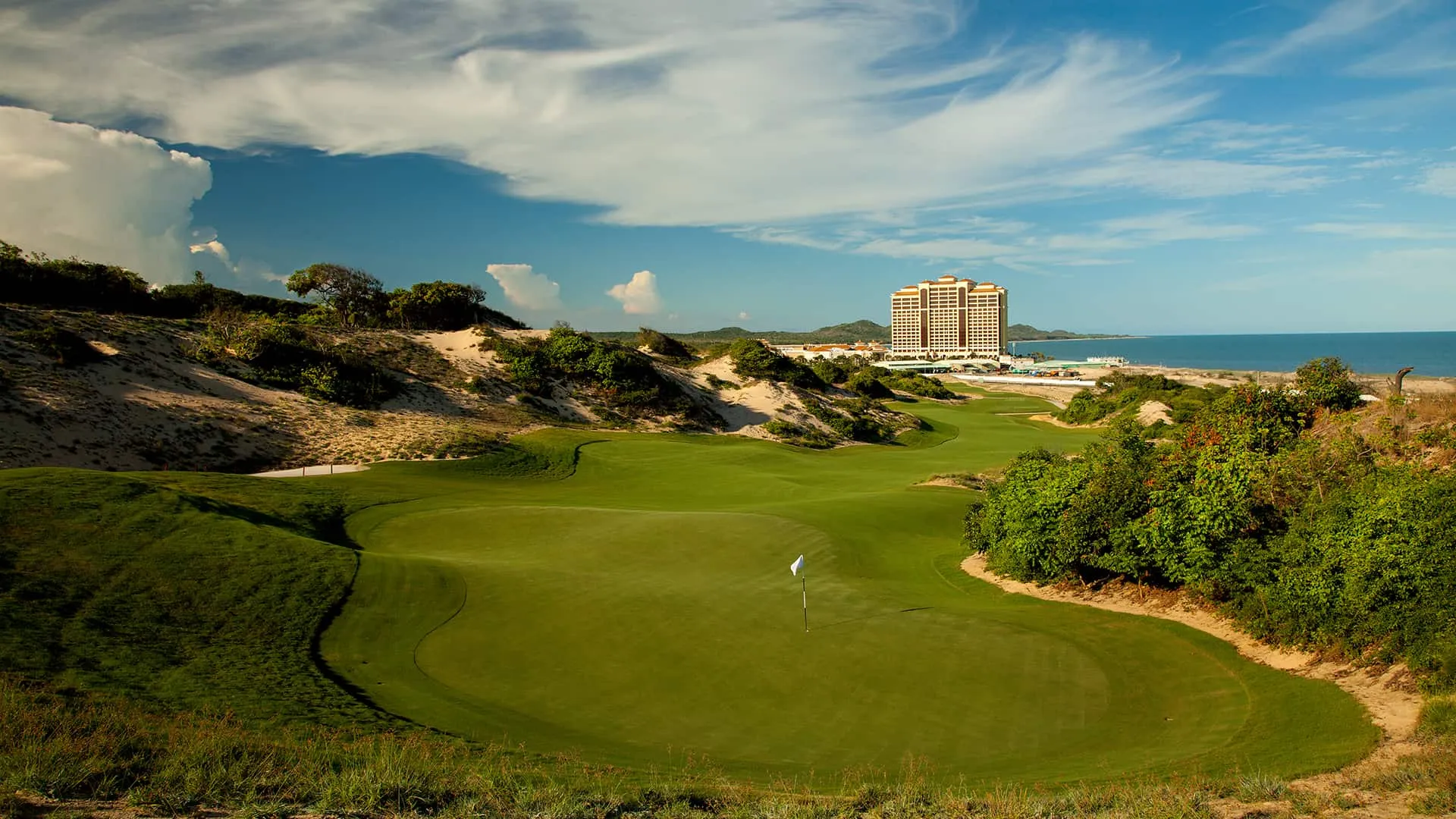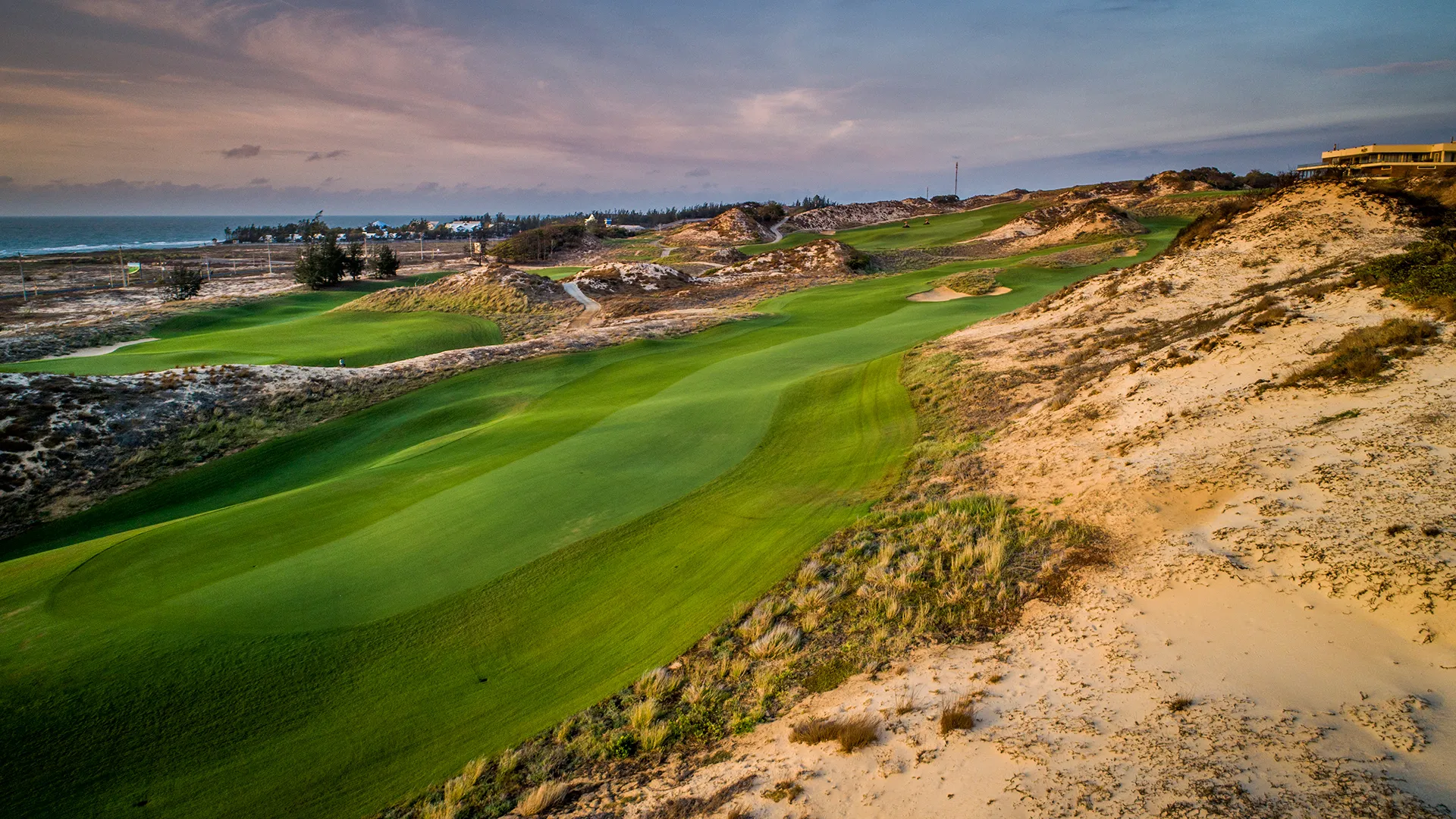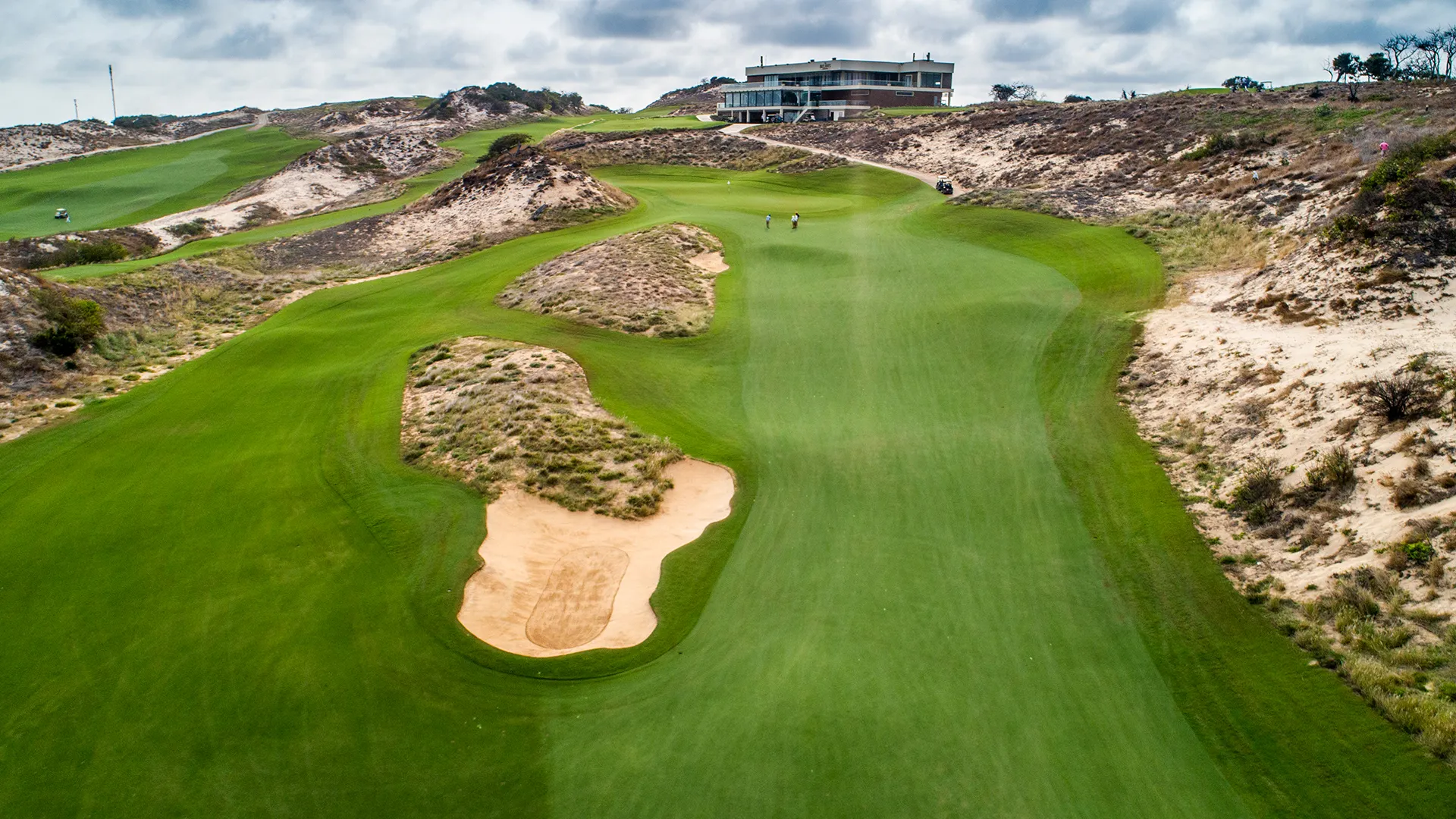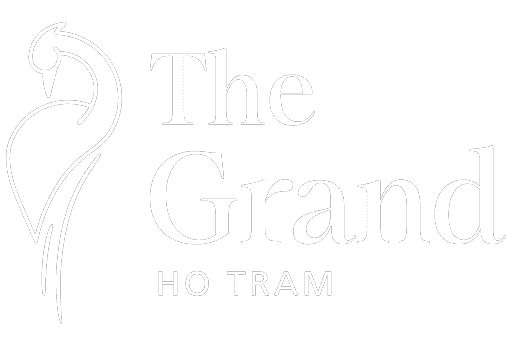Golf Course
Course Overview
The Bluffs Grand Ho Tram was designed to capture the true essence of links-style golf. Set on the coastline — as almost all great links courses are — The Bluffs is routed over and around towering sand dunes, which have been shaped over thousands of years by the elements. The wind plays a major role in the experience here, its always there, and its prevailing direction and strength differs depending on the time of year. Said the course’s designer, Greg Norman: “The experience of playing true links golf among the dunes of southern Vietnam and having dramatic ocean views throughout your round has made The Bluffs Grand Ho Tram one of the most unique golf experiences in the world.”




hole by hole
challenge yourself
Hole 1Hole 2Hole 3Hole 4Hole 5Hole 6Hole 7Hole 8Hole 9Hole 10Hole 11Hole 12Hole 13Hole 14Hole 15Hole 16Hole 17Hole 18
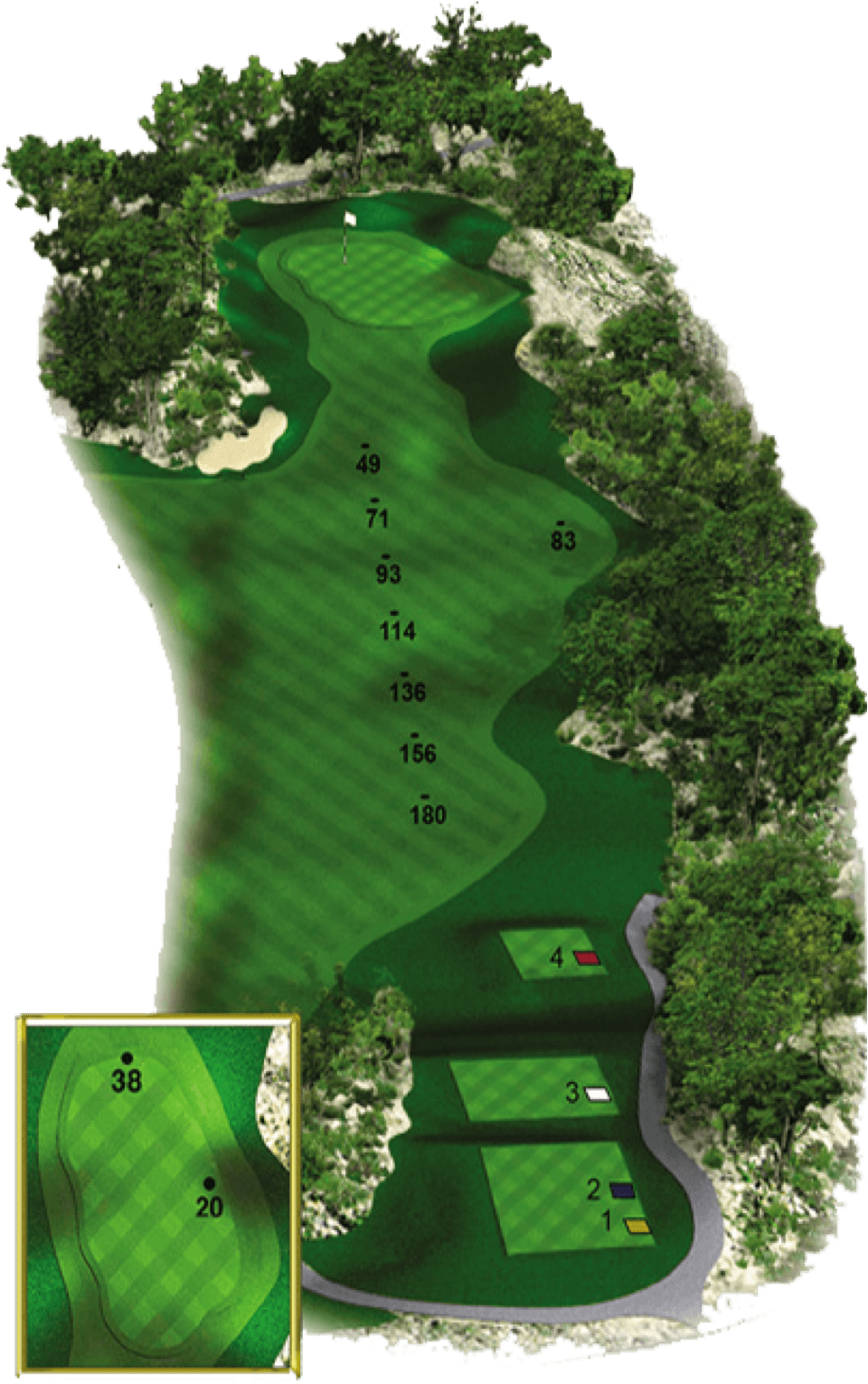
Hole 1 - Par 4
Stroke Index WET Season:
Men: 18
Ladies: 18
Stroke Index DRY Season:
Men: 17
Ladies: 17
Yardages:
337
326
326
299
248
Much like the opening hole at storied St. Andrews, the 1st is a par 4 that shares a fairway with another hole (the 9th), making it a very manageable start to the round. But the straighter the tee shot, the more straightforward the approach. Favor the left side of the elevated green with your second, as there’s good chance a miss in that direction will still kick onto the putting surface.
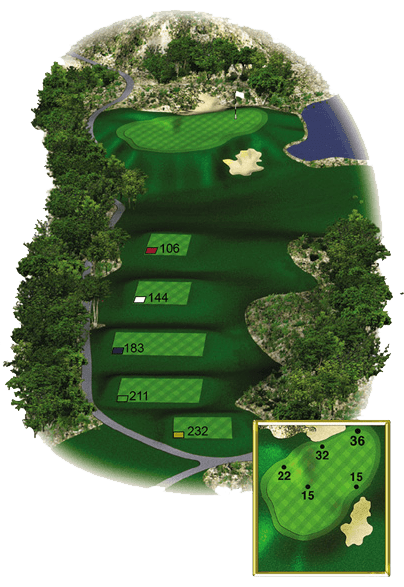
Hole 2 – Par 3
Stroke Index WET Season:
Men: 10
Ladies: 12
Stroke Index DRY Season:
Men: 5
Ladies: 7
Yardages:
232
175
144
144
106
The first of the short holes at The Bluffs is also one of the most difficult. While it plays downhill, it’s very well protected — national forest left (out of bounds), a large front bunker and another behind the green that are ready for any miss clubbed shots. Play the yardage and make a smooth, confident swing. A relatively flat green is the reward for those who manage to find it.
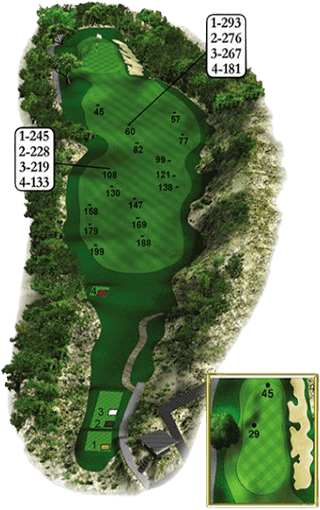
Hole 3 – Par 4
Stroke Index WET Season:
Men: 8
Ladies: 10
Stroke Index DRY Season:
Men: 1
Ladies: 1
Yardages:
376
352
352
351
268
Don’t be fooled by this straightaway par 4’s ‘blind’ tee shot; there is more room out there than can be seen from the teeing area. Left-center of the fairway offers the best angle to come in from, as the green is guarded all along on the right by a large, deep bunker. The green also slants toward the trap, so any chip or putt attempted in that direction ought to be played with soft hands.
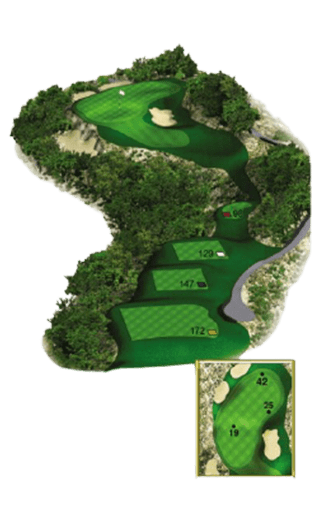
Hole 4 – Par 3
Stroke Index WET Season:
Men: 14
Ladies: 14
Stroke Index DRY Season:
Men: 7
Ladies: 9
Yardages:
172
142
142
129
98
The second par 3 is considerably shorter than the first, but with an extremely steep trap front left reminiscent of the 4th hole bunker at Royal St Georges, and a pot bunker front right, it’s extremely well defended. It’s also more exposed. Give extra consideration to the wind’s strength and direction before selecting a club. Then take aim at the middle of the green, whether the pin’s there or not. Par is an excellent score.
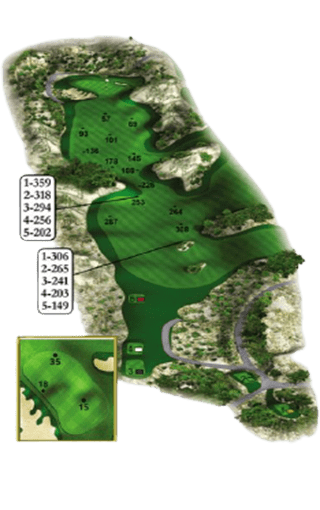
Hole 5 – Par 5
Stroke Index WET Season:
Men: 2
Ladies: 2
Stroke Index DRY Season:
Men: 11
Ladies: 11
Yardages:
635
558
558
528
474
The first of back-to-back par 5s runs parallel to the ocean, and only about a 5-iron from it. The only bad tee shot is one that goes left. So favor the right side of the fairway, and play to the middle of the fairway with your second shot. It’s a long way home here, so positioning yourself for a nice short-iron approach is key to a birdie chance. A large slope short right of the green will can be navigated to run a ball onto the green.
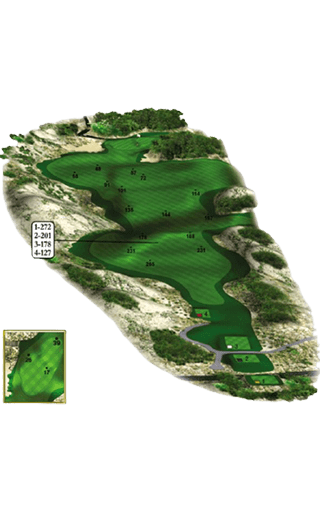
Hole 6 – Par 5
Stroke Index WET Season:
Men: 16
Ladies: 16
Stroke Index DRY Season:
Men: 9
Ladies: 5
Yardages:
542
465
465
447
396
The fairway on this medium-length, uphill par-5 slopes significantly from left to right. The green is reachable in two for long hitters, though a deep trough where most good tee shots tend to settle makes accomplishing that feat tricky. An immense bunker guards the front right side of the green, while anything long will trundle away considerably.
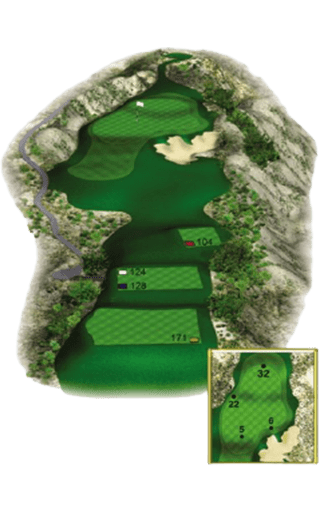
Hole 7 – Par 3
Stroke Index WET Season:
Men: 4
Ladies: 6
Stroke Index DRY Season:
Men: 15
Ladies: 13
Yardages:
171
128
128
124
104
Contrary to the first two par 3s, this one plays slightly uphill. But the green is wide, and the views from the tee box are spectacular. Take an extra club to compensate for the elevation difference between tee and green, and perhaps another to make sure you carry the large bunker that guards the entire right half of the putting surface. Get your par and get out.
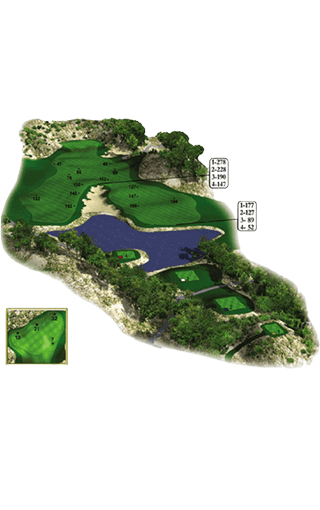
Hole 8 – Par 4
Stroke Index WET Season:
Men: 12
Ladies: 8
Stroke Index DRY Season:
Men: 13
Ladies: 15
Yardages:
412
359
359
326
282
The only hole with a forced carry-over water is shorter than it looks. Left or right?..A large bunker splits the fairway, but a well-struck drive should take it completely out of the equation. The approach plays slightly uphill to a bowled green tucked in the sand dunes. So while the putting surface is difficult to see from distance, its funnel effect tends to reward even the slightly errant shot.
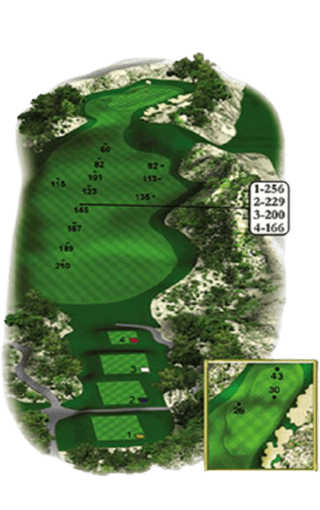
Hole 9 – Par 4
Stroke Index WET Season:
Men: 6
Ladies: 4
Stroke Index DRY Season:
Men: 3
Ladies: 3
Yardages:
424
390
390
367
334
Like the 18th at St. Andrews, there is plenty of room left off this tee, as it shares a fairway with the first. The longer the drive though, the better; the second shot plays uphill to a green that falls off sharply to the right. Take enough club to carry the trouble. Or aim left, where the lack of bunkers makes for the easiest area from which to get up and down.
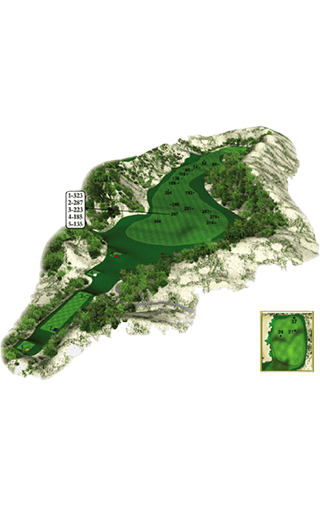
Hole 10 – Par 5
Stroke Index WET Season:
Men: 1
Ladies: 1
Stroke Index DRY Season:
Men: 4
Ladies: 4
Yardages:
615
555
530
504
428
The back nine starts with a true, three-shot par 5 (615 yards from the championship tees) that includes a blind second shot. The tiered green sits perched between a sand trap left and a waste area that wraps from front right to back left. The best angle in is from the left. Anything hit toward the right part of the green should carom toward the middle.
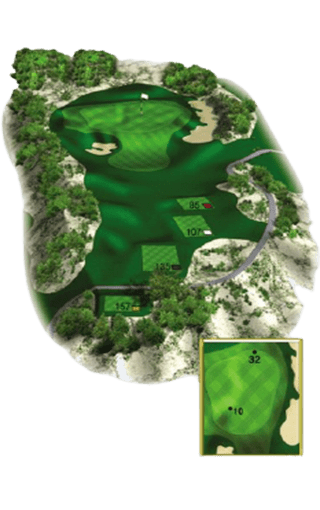
Hole 11 – Par 3
Stroke Index WET Season:
Men: 17
Ladies: 17
Stroke Index DRY Season:
Men: 14
Ladies: 14
Yardages:
157
120
120
107
85
One of the more breathtaking holes at The Bluffs, this par 3 is back dropped by the never-ending blue ocean and The Grand Ho Tram Strip. Don’t let yourself get too distracted though; bunkers will snatch anything right and short left. The green is larger than it appears from the tee, so stay calm and make a good swing. Then take an extra minute to drink in the view.
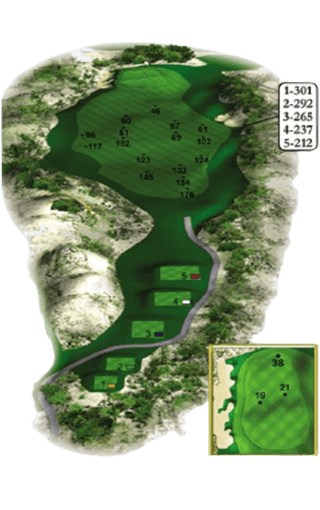
Hole 12 – Par 4
Stroke Index WET Season:
Men: 15
Ladies: 15
Stroke Index DRY Season:
Men: 12
Ladies: 12
Yardages:
392
359
359
331
307
A downhill, drivable par 4 presents the opportunity to ‘get one back.’ But with a large front left bunker guarding the undulating green, birdie is no guarantee. If you’re confident in your short game, go for it. If not, play to a comfortable approach-shot yardage and punch it on. Be warned that anything long will find the bushes.
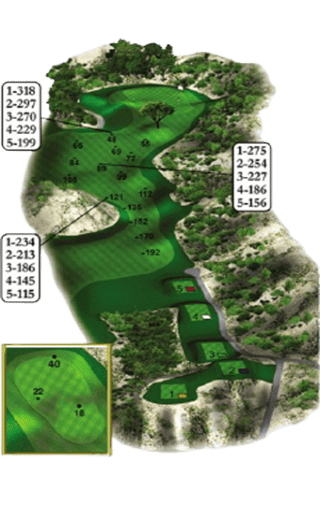
Hole 13 – Par 4
Stroke Index WET Season:
Men: 7
Ladies: 9
Stroke Index DRY Season:
Men: 18
Ladies: 16
Yardages:
386
360
320
296
267
With a tree in the fairway just short of the green, this picturesque par 4 is one to remember. Long hitters will be tempted to pull driver, but beware of the aggressive line; anything right off the tee probably won’t find its way off the scrubby hillside and 40ft wall of a sand dune. The high-percentage play is a long iron left of center, followed by a short iron to a challenging but fun green.
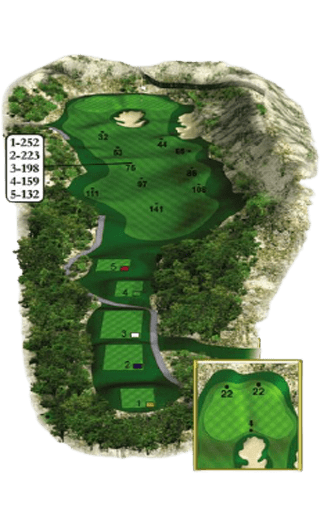
Hole 14 – Par 4
Stroke Index WET Season:
Men: 9
Ladies: 7
Stroke Index DRY Season:
Men: 16
Ladies: 18
Yardages:
340
312
312
285
219
This short par 4 is as straightforward as they come. With a fairway banked on both sides by steep dunes, the first objective is clear: get the ball in play. From the fairway, the hole plays uphill to an amphitheater green, protected by a deep bunker front middle. A ridge bisects the putting surface, making any putt from one side to the other a major test.
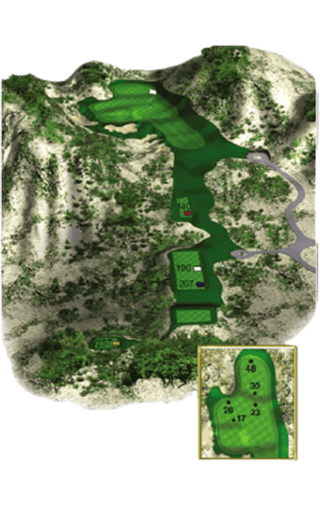
Hole 15 – Par 3
Stroke Index WET Season:
Men: 5
Ladies: 5
Stroke Index DRY Season:
Men: 8
Ladies: 8
Yardages:
257
190
185
185
140
Even the best of golfers will be challenged here; not only is this par 3 the course’s longest, it plays uphill to the highest part of the property. What’s more, a waste area runs from the tee ground all the way up to the left side of the green. A dune right of the green means the only real bailout area is short right. Be sure to take in the views across the bay area from the back of the green.
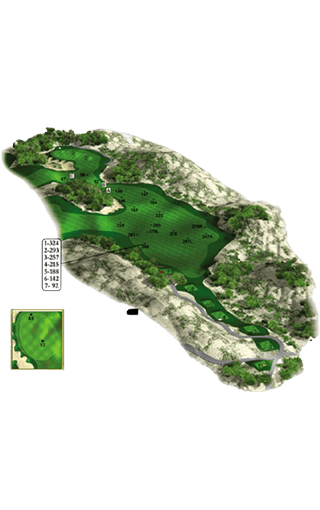
Hole 16 – Par 5
Stroke Index WET Season:
Men: 13
Ladies: 11
Stroke Index DRY Season:
Men: 2
Ladies: 2
Yardages:
651
575
530
530
419
From the course’s longest par 3 to the longest par 5. But don’t be intimidated; it plays downhill most of the way, and there’s a lot of room off the tee. Anything left, however, will make it difficult to see the green and even the lay-up area. The green complex is big, tricky and fun.

Hole 17 – Par 4
Stroke Index WET Season:
Men: 11
Ladies: 13
Stroke Index DRY Season:
Men: 6
Ladies: 10
Yardages:
419
367
346
317
271
The last of the downhill par 4s offers a real scoring chance. A good tee shot will leave a short iron in. But don’t get complacent. A narrow bunker guards the entire right side. The safe approach is one played toward the left side of the putting surface. Even short left is ok; it’s relatively flat, making for one of the easier up-and-down opportunities on the course.
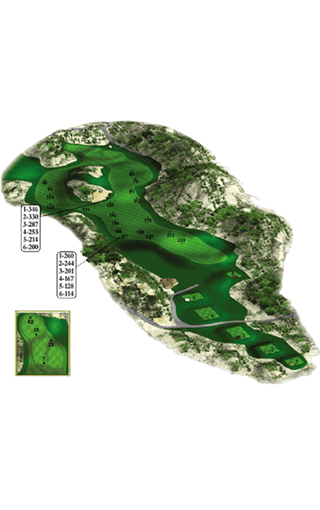
Hole 18 – Par 4
Stroke Index WET Season:
Men: 3
Ladies: 3
Stroke Index DRY Season:
Men: 10
Ladies: 6
Yardages:
489
425
425
389
354
The home hole is as mighty as they come. Not only is it the longest par 4 on the course (489 yards from the tips), it plays uphill all the way. A big, beautiful drive should come to rest where the fairway begins to dogleg right. A good approach is one played toward the back right portion of the green, where a bank is sure to kick the ball onto the putting surface.
Hole 1 - Par 4
×
Stroke Index WET Season:
Men: 18
Ladies: 18
Stroke Index DRY Season:
Men: 17
Ladies: 17
Yardages:
337
326
326
299
248
Much like the opening hole at storied St. Andrews, the 1st is a par 4 that shares a fairway with another hole (the 9th), making it a very manageable start to the round. But the straighter the tee shot, the more straightforward the approach. Favor the left side of the elevated green with your second, as there’s good chance a miss in that direction will still kick onto the putting surface.
Hole 2 – Par 3
×
Stroke Index WET Season:
Men: 10
Ladies: 12
Stroke Index DRY Season:
Men: 5
Ladies: 7
Yardages:
232
175
144
144
106
The first of the short holes at The Bluffs is also one of the most difficult. While it plays downhill, it’s very well protected — national forest left (out of bounds), a large front bunker and another behind the green that are ready for any miss clubbed shots. Play the yardage and make a smooth, confident swing. A relatively flat green is the reward for those who manage to find it.
Hole 3 – Par 4
×
Stroke Index WET Season:
Men: 8
Ladies: 10
Stroke Index DRY Season:
Men: 1
Ladies: 1
Yardages:
376
352
352
351
268
Don’t be fooled by this straightaway par 4’s ‘blind’ tee shot; there is more room out there than can be seen from the teeing area. Left-center of the fairway offers the best angle to come in from, as the green is guarded all along on the right by a large, deep bunker. The green also slants toward the trap, so any chip or putt attempted in that direction ought to be played with soft hands.
Hole 4 – Par 3
×
Stroke Index WET Season:
Men: 14
Ladies: 14
Stroke Index DRY Season:
Men: 7
Ladies: 9
Yardages:
172
142
142
129
98
The second par 3 is considerably shorter than the first, but with an extremely steep trap front left reminiscent of the 4th hole bunker at Royal St Georges, and a pot bunker front right, it’s extremely well defended. It’s also more exposed. Give extra consideration to the wind’s strength and direction before selecting a club. Then take aim at the middle of the green, whether the pin’s there or not. Par is an excellent score.
Hole 5 – Par 5
×
Stroke Index WET Season:
Men: 2
Ladies: 2
Stroke Index DRY Season:
Men: 11
Ladies: 11
Yardages:
635
558
558
528
474
The first of back-to-back par 5s runs parallel to the ocean, and only about a 5-iron from it. The only bad tee shot is one that goes left. So favor the right side of the fairway, and play to the middle of the fairway with your second shot. It’s a long way home here, so positioning yourself for a nice short-iron approach is key to a birdie chance. A large slope short right of the green will can be navigated to run a ball onto the green.
Hole 6 – Par 5
×
Stroke Index WET Season:
Men: 16
Ladies: 16
Stroke Index DRY Season:
Men: 9
Ladies: 5
Yardages:
542
465
465
447
396
The fairway on this medium-length, uphill par-5 slopes significantly from left to right. The green is reachable in two for long hitters, though a deep trough where most good tee shots tend to settle makes accomplishing that feat tricky. An immense bunker guards the front right side of the green, while anything long will trundle away considerably.
Hole 7 – Par 3
×
Stroke Index WET Season:
Men: 4
Ladies: 6
Stroke Index DRY Season:
Men: 15
Ladies: 13
Yardages:
171
128
128
124
104
Contrary to the first two par 3s, this one plays slightly uphill. But the green is wide, and the views from the tee box are spectacular. Take an extra club to compensate for the elevation difference between tee and green, and perhaps another to make sure you carry the large bunker that guards the entire right half of the putting surface. Get your par and get out.
Hole 8 – Par 4
×
Stroke Index WET Season:
Men: 12
Ladies: 8
Stroke Index DRY Season:
Men: 13
Ladies: 15
Yardages:
412
359
359
326
282
The only hole with a forced carry-over water is shorter than it looks. Left or right?..A large bunker splits the fairway, but a well-struck drive should take it completely out of the equation. The approach plays slightly uphill to a bowled green tucked in the sand dunes. So while the putting surface is difficult to see from distance, its funnel effect tends to reward even the slightly errant shot.
Hole 9 – Par 4
×
Stroke Index WET Season:
Men: 6
Ladies: 4
Stroke Index DRY Season:
Men: 3
Ladies: 3
Yardages:
424
390
390
367
334
Like the 18th at St. Andrews, there is plenty of room left off this tee, as it shares a fairway with the first. The longer the drive though, the better; the second shot plays uphill to a green that falls off sharply to the right. Take enough club to carry the trouble. Or aim left, where the lack of bunkers makes for the easiest area from which to get up and down.
Hole 10 – Par 5
×
Stroke Index WET Season:
Men: 1
Ladies: 1
Stroke Index DRY Season:
Men: 4
Ladies: 4
Yardages:
615
555
530
504
428
The back nine starts with a true, three-shot par 5 (615 yards from the championship tees) that includes a blind second shot. The tiered green sits perched between a sand trap left and a waste area that wraps from front right to back left. The best angle in is from the left. Anything hit toward the right part of the green should carom toward the middle.
Hole 11 – Par 3
×
Stroke Index WET Season:
Men: 17
Ladies: 17
Stroke Index DRY Season:
Men: 14
Ladies: 14
Yardages:
157
120
120
107
85
One of the more breathtaking holes at The Bluffs, this par 3 is back dropped by the never-ending blue ocean and The Grand Ho Tram Strip. Don’t let yourself get too distracted though; bunkers will snatch anything right and short left. The green is larger than it appears from the tee, so stay calm and make a good swing. Then take an extra minute to drink in the view.
Hole 12 – Par 4
×
Stroke Index WET Season:
Men: 15
Ladies: 15
Stroke Index DRY Season:
Men: 12
Ladies: 12
Yardages:
392
359
359
331
307
A downhill, drivable par 4 presents the opportunity to ‘get one back.’ But with a large front left bunker guarding the undulating green, birdie is no guarantee. If you’re confident in your short game, go for it. If not, play to a comfortable approach-shot yardage and punch it on. Be warned that anything long will find the bushes.
Hole 13 – Par 4
×
Stroke Index WET Season:
Men: 7
Ladies: 9
Stroke Index DRY Season:
Men: 18
Ladies: 16
Yardages:
386
360
320
296
267
With a tree in the fairway just short of the green, this picturesque par 4 is one to remember. Long hitters will be tempted to pull driver, but beware of the aggressive line; anything right off the tee probably won’t find its way off the scrubby hillside and 40ft wall of a sand dune. The high-percentage play is a long iron left of center, followed by a short iron to a challenging but fun green.
Hole 14 – Par 4
×
Stroke Index WET Season:
Men: 9
Ladies: 7
Stroke Index DRY Season:
Men: 16
Ladies: 18
Yardages:
340
312
312
285
219
This short par 4 is as straightforward as they come. With a fairway banked on both sides by steep dunes, the first objective is clear: get the ball in play. From the fairway, the hole plays uphill to an amphitheater green, protected by a deep bunker front middle. A ridge bisects the putting surface, making any putt from one side to the other a major test.
Hole 15 – Par 3
×
Stroke Index WET Season:
Men: 5
Ladies: 5
Stroke Index DRY Season:
Men: 8
Ladies: 8
Yardages:
257
190
185
185
140
Even the best of golfers will be challenged here; not only is this par 3 the course’s longest, it plays uphill to the highest part of the property. What’s more, a waste area runs from the tee ground all the way up to the left side of the green. A dune right of the green means the only real bailout area is short right. Be sure to take in the views across the bay area from the back of the green.
Hole 16 – Par 5
×
Stroke Index WET Season:
Men: 13
Ladies: 11
Stroke Index DRY Season:
Men: 2
Ladies: 2
Yardages:
651
575
530
530
419
From the course’s longest par 3 to the longest par 5. But don’t be intimidated; it plays downhill most of the way, and there’s a lot of room off the tee. Anything left, however, will make it difficult to see the green and even the lay-up area. The green complex is big, tricky and fun.
Hole 17 – Par 4
×
Stroke Index WET Season:
Men: 11
Ladies: 13
Stroke Index DRY Season:
Men: 6
Ladies: 10
Yardages:
419
367
346
317
271
The last of the downhill par 4s offers a real scoring chance. A good tee shot will leave a short iron in. But don’t get complacent. A narrow bunker guards the entire right side. The safe approach is one played toward the left side of the putting surface. Even short left is ok; it’s relatively flat, making for one of the easier up-and-down opportunities on the course.
Hole 18 – Par 4
×
Stroke Index WET Season:
Men: 3
Ladies: 3
Stroke Index DRY Season:
Men: 10
Ladies: 6
Yardages:
489
425
425
389
354
The home hole is as mighty as they come. Not only is it the longest par 4 on the course (489 yards from the tips), it plays uphill all the way. A big, beautiful drive should come to rest where the fairway begins to dogleg right. A good approach is one played toward the back right portion of the green, where a bank is sure to kick the ball onto the putting surface.
Scorecard
- red
- blue wet
- blue dry
- white
- gold
71.0 RATING
71.7 RATING
70.7 RATING
69.3 RATING
75.5 RATING
128 SLOPE
138 SLOPE
136 SLOPE
132 SLOPE
146 SLOPE
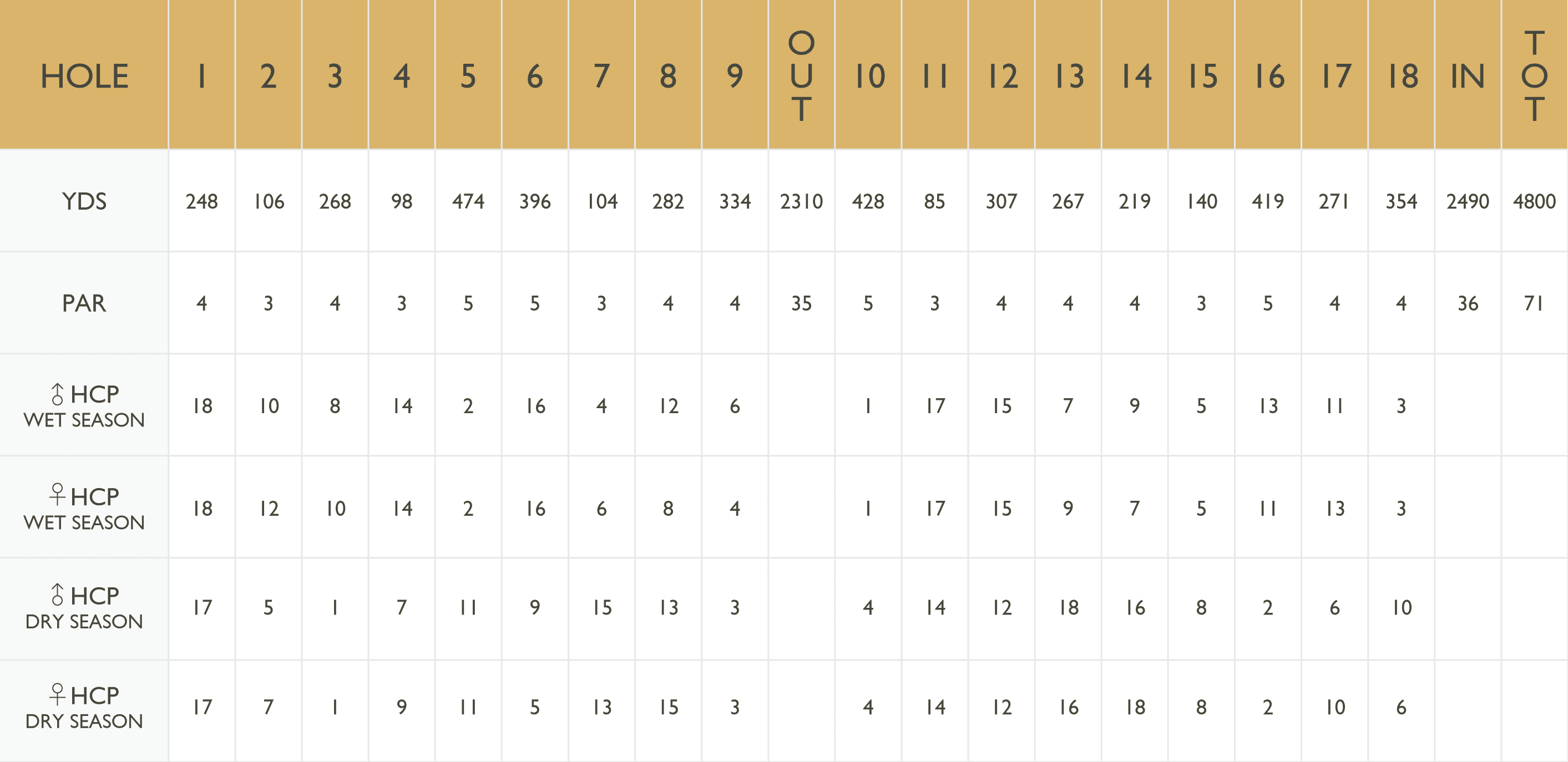




Greg Norman
The Bluffs Grand Ho Tram was designed by a true legend of the game: Greg Norman. The ‘Great White Shark’ as he’s lovingly called, spent an astounding 331 weeks atop the world golf rankings and won the Open Championship twice. His Florida-based design firm has conceived over 100 international- standard layouts worldwide. But if you ask him, few compared to what he has created at The Bluffs Ho Tram. “We begin each new golf course design with a least-disturbance approach. Our design team dedicates time and effort to finding the most desirable natural features of a site and incorporates them into the routing. Streams, rock features, vegetation and undulating topography are a few natural elements that can provide a golf course with its own unique feel when incorporated into the playing strategy” “This is one of only two pieces of land of this quality and character I have ever been given to work with — the other being Doonbeg [in Ireland],” Norman said.” I’m a firm believer in using what Mother Nature gives us on a particular site. This one has it all.”


